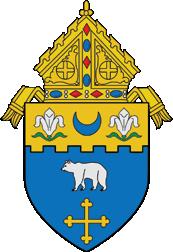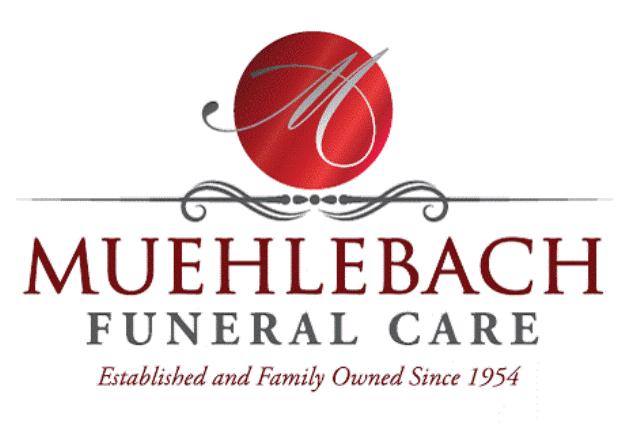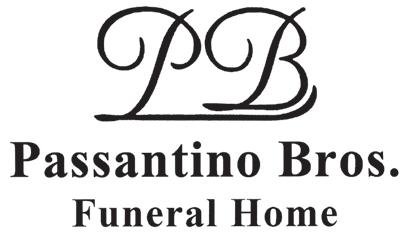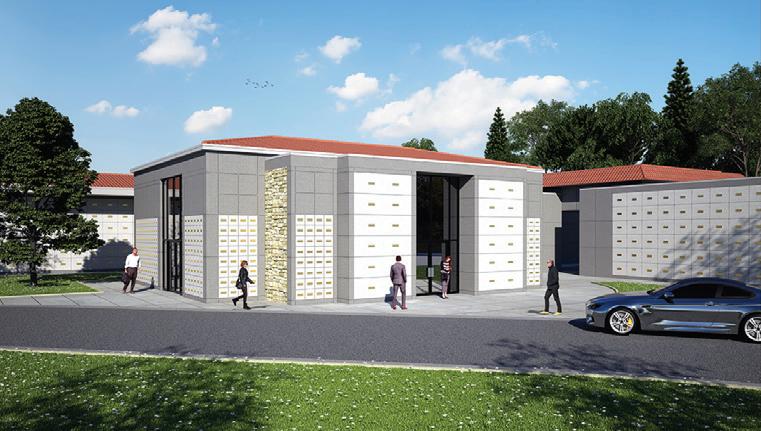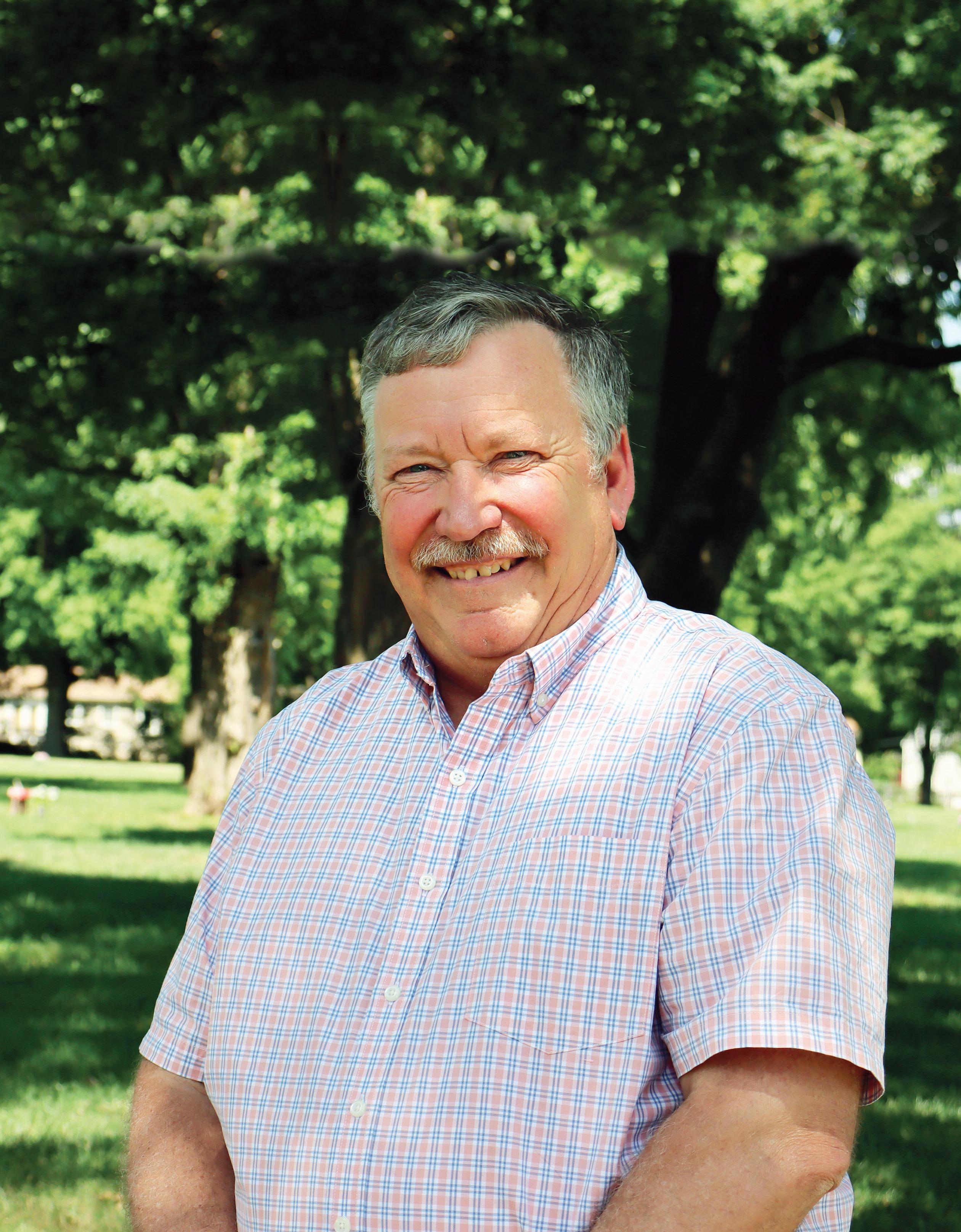

Faithful Citizenship: Forming Consciences
As the 2022 election draws nearer, we must all consider our duty to vote, even though making decisions about ballot selections can be challenging. In this edition of Messenger, we aim to provide our readers with helpful tools, such as information from the United States Conference of Catholic Bishops' (USCCB) publication, Forming Consciences for Faithful Citizenship, along with a look at the recreational marijuana ballot initiative Missourians will consider.




As Catholics, we are called to act as responsible citizens and participate, each in our own way, in political life to promote the common good. However, many find it di icult to engage in the political process, especially in these times of extreme partisanship. Bishop Shawn McKnight (Diocese of Je erson City) joins us to discuss how Catholics can form their consciences in order to answer the Church’s call to faithful citizenship in the latest episode of the MCC from the Capitol podcast.

Scan here to listen




The magazine
Kansas City-St. Joseph
COVER STORY
mission in regular life outside their parish — but what does that look like in action?
Bishop James V. Johnston, Jr. Publisher Ashlie Hand Editor Megan Marley Assistant editor Jenny Pomicter Graphic designerTo submit story ideas and news, send emails to marley@diocesekcsj.org
www.FAITHcatholic.com

Catholic Key (ISSN 2769-2353, USPS 024-190) is a membership publication of the Diocese of Kansas City-St. Joseph, published bimonthly (Feb/ Mar, Apr/May, Jun/Jul, Aug/ Sep, Oct/Nov, Dec/Jan) by the Diocese of Kansas City-St. Joseph, The Catholic Center, 20 W. Ninth St., Kansas City, MO 64105. Periodicals Postage Paid at Kansas City, MO and at additional mailing offices.
POSTMASTER: Send address changes to Catholic Key, The Catholic Center, 20 W. Ninth St., Kansas City, MO 64105. ©2022
Catholic Key, Diocese of Kansas City-St. Joseph.
ON THE COVER: Kenny Gilbert, Cath olic Cemeteries' new General Manager. Photo by Megan Marley.

Marty Denzer
is long-time writer in residence for the Catholic Key.
14
Holy ground | Catholic Cemeteries provide a sacred home for love and loss | Ashlie Hand
The four Catholic cemeteries managed by our diocese are sa cred places where families vis it and reconnect with a part of those they have loved and lost.
Few understand this better than Catholic Cemeteries’ new Gen eral Manager, Kenny Gilbert. As Kenny settles into his new role, he already feels at home and ready to embrace new opportunities for serving families in our diocese who need a special place to honor their loved ones.
4
On the Way | Last Holy Communion | Bishop Johnston
One of the happiest days in a family is when a child or an adult celebrates the reception of First Holy Communion. What is often overlooked, or that many may not be aware of, is what might be called Last Holy Communion, or Viaticum
8
To Serve and Lift | You are not alone | Susan Walker
Faith-filled people who want to use their time and skill to make life better for everyone take up the volunteer mantle with dozens of others and know that they are not alone in their desire to serve.
12
Growing God’s Family | Vocation Awareness Month
| Marty Denzer
For Eric Wachira, Year II semi narian at Conception Seminary, and Sister Photina, Novice with the Benedictines of Mary, Queen of Apostles in Gower, answering God’s call to religious life has been filled with blessings.
20 Alexandra’s House | Labor of love | Megan Marley
Alexandra’s House is one of the first ministries to provide practi cal support for perinatal hospice and loss of a baby in the Kansas City area.
22
Black Catholic History Month | Bridget Locke
6 Using Our Resources Wisely
| Discerning how to use the
Holy Spirit's gifts | Marty Denzer
The Activate Your Baptism survey is designed to show the laity how they can realize their apostolic
Launched a little more than 30 years ago, Black Catholic His tory Month is recognized each November to ensure that the con tributions of Catholics of African descent are acknowledged with intention and consistency.
Ashlie Hand leads the Office of Communications for the Diocese of Kansas CitySt. Joseph.
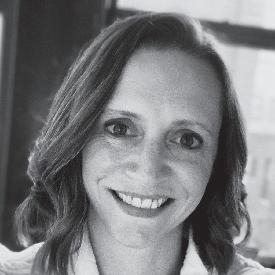
Bridget Locke loves God and people. Learn more about her life and work at bnlcomms.com.
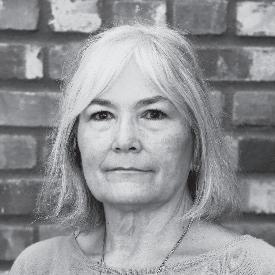

Megan Marley is Communications Manager for the Diocese of Kansas CitySt. Joseph.
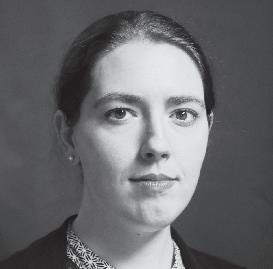
26
Top 5 Hispanic holiday tra ditions you need to know about | Leyden Rovelo-Krull
Learn more about five of the more popular Hispanic holiday tradi tions commonly celebrated by Latinos in our diocese.
32 Healing Our Family | Building trust | Ashlie Hand Carrie Cooper has spent the last 11 years overseeing the diocese’s response and prevention efforts related to child sexual abuse and suspicious sexual behavior, care fully and intentionally rebuilding the trust lost due to abuse of mi nors in our diocese.
35 Eucharistic Revival |
An Adoration road map | Megan Marley
It can be easier to enter into a deeper relationship with our Eu charistic Lord when His house is open for you to visit Him.
EN ESPANOL
24 El Dia De Los Muertos | Diácono Juan Garcia
28 En Camino |Última Sagrada Comunión | Obispo Johnston
27 ¡Las 5 Principales tradiciones navideñas hispanas que debe conocer! | Leyden Rovelo-Krull
Leyden Rovelo-Krull leads the Office of Hispanic Ministry for the Diocese of Kansas City-St. Joseph.
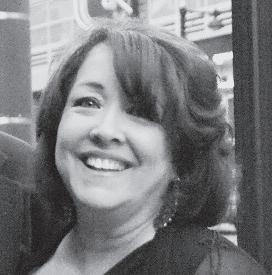
Susan Walker leads the Outreach and Engagement team at Catholic Charities KCSJ.

Last Holy
Communion
One of the happiest days in a family is when a child or an adult celebrates the reception of First Holy Communion — personally receiving the Holy Eucharist, the body of Christ, for the first time. I still have the small prayer book, rosary, holy cards, statuette, and other remembrances from my First Holy Communion tucked away in a box somewhere, along with the photograph of the large class of second graders who shared that day with me.

What is often overlooked, or that many may not be aware of, is what might be called “Last Holy Communion.” The official name for this is Viaticum. The name derives from the Latin word “way” and the “provisions needed for making a journey.” More specifically, Viaticum refers to Holy Communion for the dying. The Instruction for the Celebration of Viaticum explains: “The celebration of the eucharist as viaticum, food for the passage through death to eternal life, is the sacrament proper to the dying Christian. It is the completion and crown of the Christian life on this earth, signifying that the Chris tian follows the Lord to eternal glory and the banquet of the heavenly kingdom.”
If reception of Viaticum is “the completion and crown of the Christian life on this earth,” it should be apparent that one’s last Holy Communion is as important as the first and is a completion in this life of what began with the sacraments of initiation: Baptism, Confirmation and Eucharist.
Because the circumstances of a dying Christian vary so widely, celebrating Viaticum can take place within the Mass or outside the Mass. Most often, priests celebrate Viaticum in the home or at a hospital or other institution where the dying person is being cared for. Often it follows the reception of the sacrament of the Anointing of the Sick.
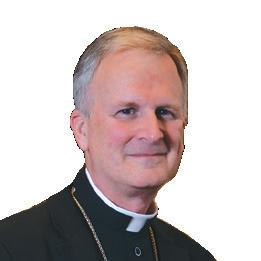
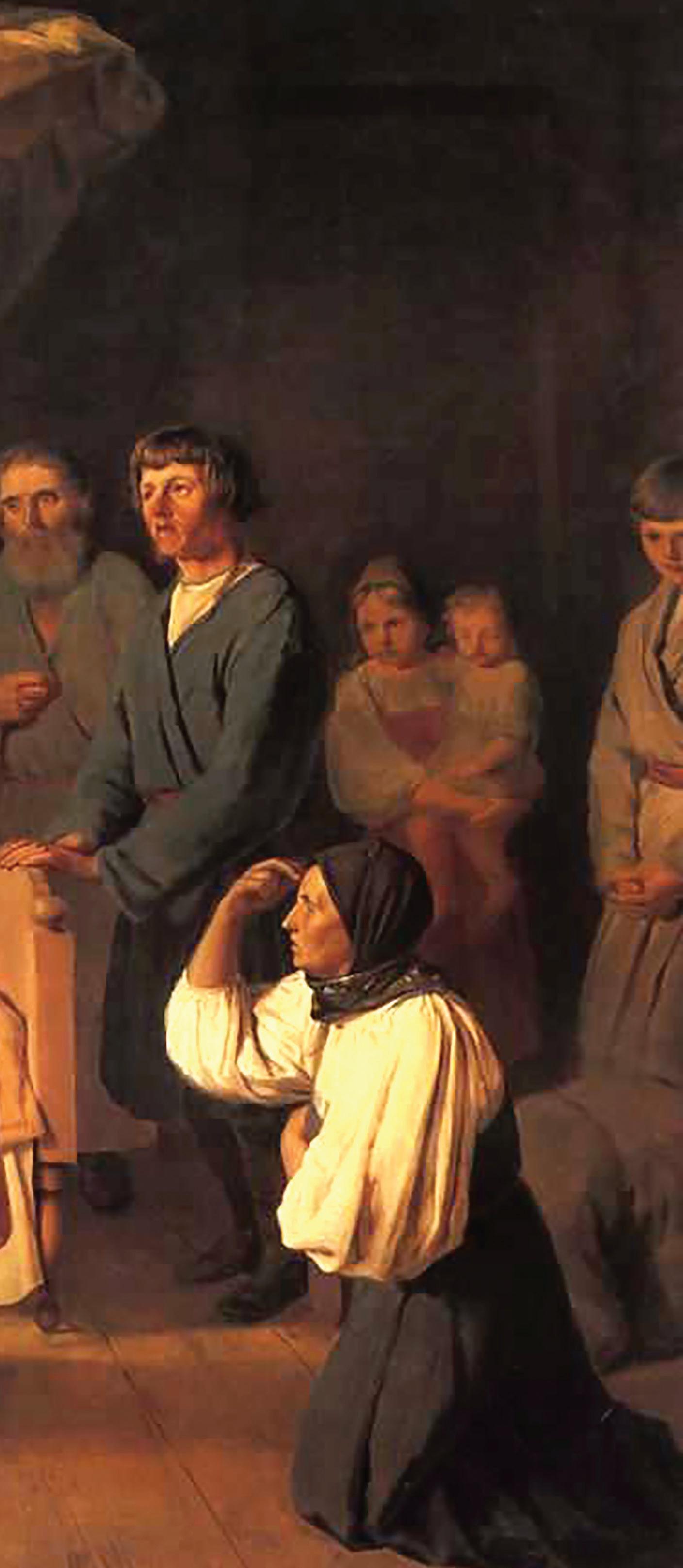
Indicating the importance of Viaticum, the Instruction goes on to say: “Priests and other ministers entrusted with the spiritual care of the sick should do everything they can to ensure that those in proximate danger of death receive the Body and Blood of Christ as viaticum.” It is assumed that the dying person is in full communion with the Church and has repented and confessed all mortal sins, as is the necessity for anyone receiving Holy Communion. That is why Viaticum is often celebrated following the rites of Anointing and Rec onciliation by a priest. However, a deacon or Extraordinary Minister of Holy Communion may administer the most im portant of the Church’s last rites: Viaticum. Obviously, Viaticum should be received when the dying person is conscious and able to swallow.
November, which begins with the Solemnity of All Saints, immediately followed by the Commemoration of All Souls, is a month in which we take special care to remember the faithful departed. We are also reminded that one day all of us will find ourselves at the “hour of our death,” something we anticipate with every Hail Mary. Along with the Blessed Mother’s intercession, let us be mindful of the precious gift of Viaticum that the Church provides for her children in that “hour” — the Holy Eucharist and our Last Holy Communion.
From the Bishop Bishop James V. Johnston, Jr. is the seventh bishop of the Diocese of Kansas City-St. Joseph
“Jesus Christ is the food for our journey: he calls us to the heavenly table.”
— From the Rite of Celebration of Viaticum
BAPTISM
By Marty Denzerhow to use the Holy
He sits at his computer, mulling over a survey on his gifts and emotional responses. Some questions are quickly answered and others more difficult. “I’m supposed to check the first answer that comes to mind? But what if that's wishful thinking? Oh well, here goes!” he thinks, clicking response number 3: Very Much Applies to Me. “But wait, am I sure?” Shrugging his shoulders, he decides to answer truthfully, not wishfully. He clicks number 1: Neutral.
Sixty questions later, he clicks “Done,” and almost immediately receives a summary of his results. Some of the gifts accorded to him surprised him; some gifts he thought he had, according to the survey, he did not, which also surprised him.
The results are designed to help the survey-taker discern gifts of the Holy Spirit and to help them find ways to put what they've learned about themselves into practice.
The survey on gifts of the Holy Spirit — personal charisms — evolved from discussions during the Diocesan Mutually Shared Vision process that called Catholics in the Diocese of Kansas City-St. Joseph to be “One Family, Restored in Christ — Equipped for Mission.” Falling under the Priority of Using Resources Wisely — buildings; resources within the chancery; the clergy and the laity — one of the survey’s intentions is to show the laity how they can realize their apostolic mission in regular life outside their parish. The results help them figure out how to use their charisms in evangelization, catechesis and pastoral service, thus aligning the gifts of God for the Church’s life and mission.
Dino Durando, Director of the diocesan Office of Domestic Church and Discipleship, designed the survey with feedback and guidance from people in the field experienced in working with this discovery and discernment process.
Father Joshua Barlett, Pastor of St. Rose of Lima Parish, Savannah and St. Patrick Mission, Forest City, and Chaplain of the Newman Catholic
Center in Maryville, said he found the survey valuable, and, in the past few years, more than 40 parishio ners and Northwest Missouri State University student leaders have taken the survey.

FOR MORE INFORMATION or to take the survey, visit www.activateyourbaptism.com

He added that younger folks seem to have a harder time with the survey than older people. “I suggest they take it again in 10 years. Perceptions and ideas change.”
“Charism” is not a common word, even for Catholics.
“The Holy Spirit takes a natural talent and infuses it with his wisdom and grace. That is a charism,” Father Barlett said.
Some are hesitant at first when encouraged to take the survey, but Father Barlett has a strategy for that.
He smiled, saying, “The questions, even if unintentionally, re-instill humility. Be objective about the questions. ‘Do I have the humility to discern, to ask the Holy Spirit how accurate the results are, relative to me, and how do I change the result or accept it?’ Let God bring us to perfection. That’s part of his job.”
Father Barlett conceded that he was surprised that he was given the gift of prophecy. “At first, I thought, no, I don’t know the date of the end of the world or what is going to happen a year from now. Then, after some reflection, I came to see that I tell the truth in the present.”
He also acknowledged the gifts of listening, an essential for a priest, and artistry. “I was amazed! Artistry, me? But then I realized I can look at a space or situation and see the beauty of it.”
Logan Poppe, a Northwest Missouri State University senior majoring in behavioral sciences, was encouraged by Father Barlett to take the survey. She said her dream job would be to be a high school counselor, as the coun selor at her high school made a huge impression on her.
She completed the survey in 2021 as a leader of Stu dents for Life, and said the results gave her direction.
When asked for ideas on helping her parish after grad uation, Logan thought for a minute. “Raising a family is a good way to help a parish, if marriage is my vocation.”
Father Barlett added, “At both St. Rose of Lima and at the Newman Center, people want to help others but aren’t sure how. The survey results can point them in the direction the Holy Spirit wants. He’ll help them help others.”
You are not alone.
My granddaughter recently shared her excitement about entering third grade this year. “It's going to be my first normal school year, “ she said. “Because, you know…,” her voice fell to almost a whisper, “Corona.”
The virus interrupted her Kindergarten year. First grade was spent primarily remote; Second grade was spent in class and remote as infections rose and fell. Even at her young age, she knows that life changed dramatically and our ways of doing things changed as well.
Catholic Charities of Kansas City-St. Joseph (CCKCSJ) was on a similar path. On March 19, 2020, we put a stake in the ground: This agency has always been committed to serving the most vulnerable in our community, and the advent of COVID-19 did not change that. The number of vulnera ble families skyrocketed overnight, however, as businesses shuttered, stores and restaurants closed, and large group gatherings canceled. The number of at-risk individuals who were furloughed from their jobs increased each day.
On that day, CCKCSJ sent out a simple email message: “We are open and here for you, if you find yourself in need of help. We are also here for you if you are looking for a way to assist people whose lives were devastated by the virus.”

The response was overwhelming.
Within hours, hundreds of people called and emailed offering their time to assist. Hundreds more flooded our online donation portal and provided funds that kept at-risk families up-to-date on rent and utility bills — and, therefore, kept them housed.
That overwhelming generosity has continued. Donations from $2 to $2 million have flowed in over the past 30 months, and every dollar has done its job to alleviate poverty. Two food pantry operations have launched: they reach into our northern rural counties as well as anchor a neighborhood in South Kansas City. Our Mom’s Empowerment program now serves families in 26 of our 27 counties, and a new program providing social emotional development for 1 to 5 year olds is serving Jackson County. Our Veterans Team rapidly places vets and their families in homes, and now is able to extend that support for up to two years, allowing them time to stabilize and exit the program more firmly self-reliant.

Last spring, at the annual Celebration of Hope Gala, staff, board members and stakeholders gathered in gratitude for all that has transpired and for the stronger, more communi ty-based agency that Cath olic Charities has become.
“Our renewed sense of community is the gracious gift of this challenging season. When they meet with Catholic Charities’ staff, atrisk families clearly hear the words ‘You are not alone.’”
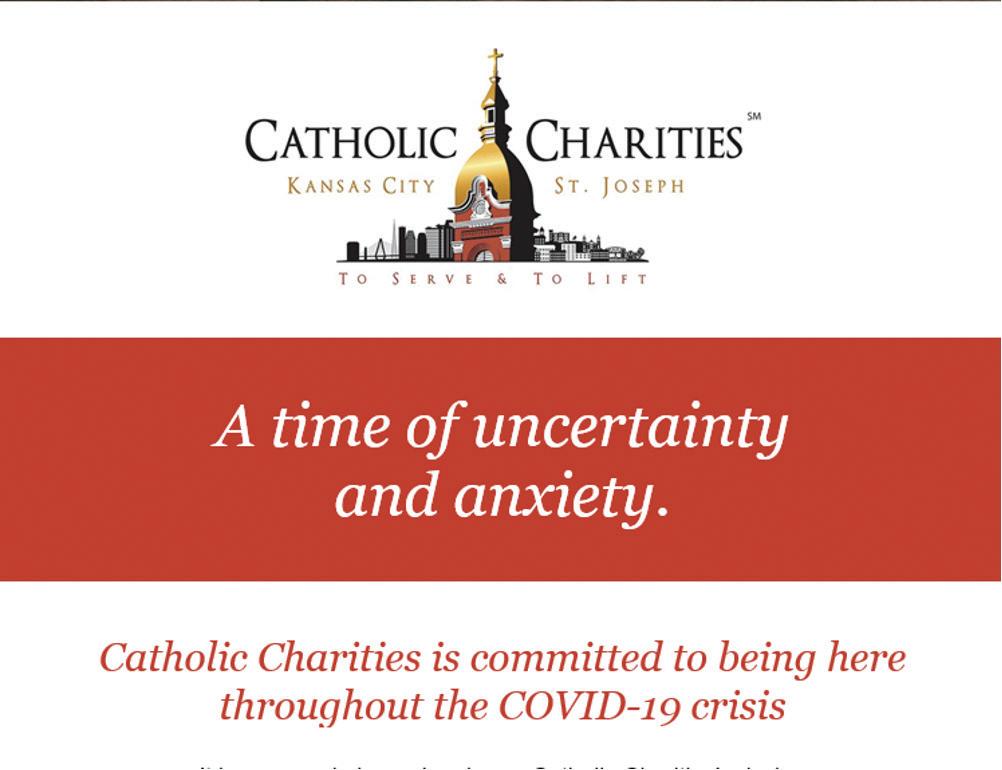
Assembled on the stage at Kansas City’s Starlight The ater, we turned to song to tell the story. Most poignant was a reference to Dear Evan Hansen’s “You Will Be Found” and its central message: you are not alone.
Our renewed sense of community is the gracious gift of this challenging sea son. When they meet with Catholic Charities’ staff, atrisk families clearly hear the words “You are not alone ” Faith-filled people who want to use their time and skill to make life better for everyone take up the volunteer mantle with dozens of others and know for certain, just by looking around, that they are not alone in their desire to serve. Those blessed with resources they can share join together in an ex panded vision of what we can do through Catholic Charities and accomplish so much more because they are not alone.
Performers at the annual Celebration of Hope Gala sang a medley of Broadway tunes capturing the Catholic Charities' story.

There's a place where we don't have to feel unknown And every time that you call out You're a little less alone
If you only say the word
From across the silence your voice is heard
—“You Will Be Found” from Dear Evan HansenDonations of $2 to $2 million have flowed into Catholic Charities over the past 30 months, every dollar going to alleviate poverty.
hope JOYFUL IN
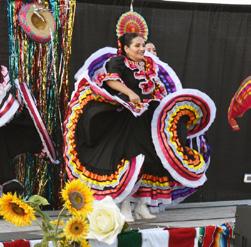
On the weekend of October 15-16, we begin our 2023 Annual Catholic Appeal, “Joyful in Hope,” taken from Romans 12:12 which aptly captures where we stand at this time in our diocesan story as we embrace our duties as disciples of Jesus. This is essential funding that impacts every parishioner and parish in the 27 counties that make up our diocese. By supporting the ACA, your gift will help in this continued work we do together today but also to prepare for our future. God has given us many blessings. Let us join together as one family and walk together in faith through acts of love as disciples of Our Lord.

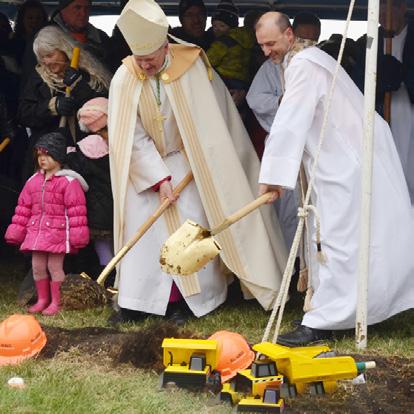

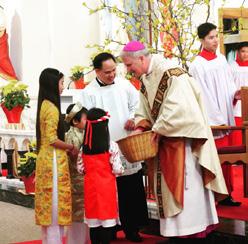


To give a gift or make a pledge to the 2023 Annual Catholic Appeal (ACA) go online and visit:
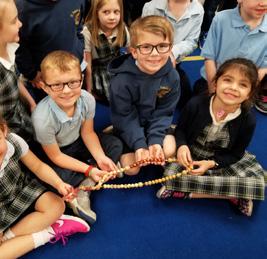

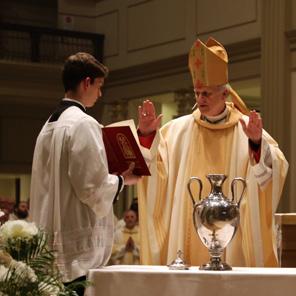
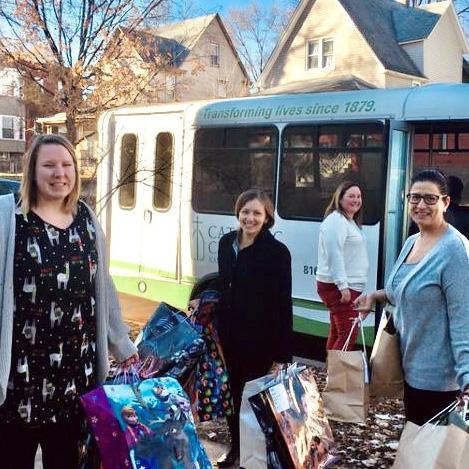
Also, while there, please take the opportunity to listen to this year’s ACA audio message.
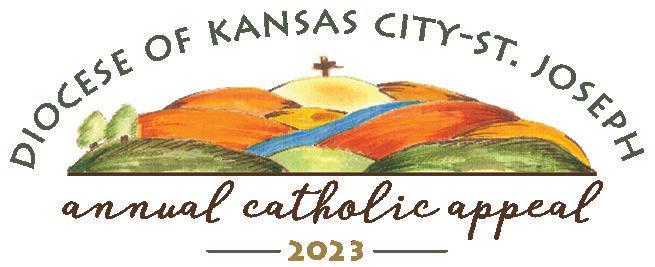
FAITH WORK at
The vast majority of the more than 1.5 million people employed in the Kansas City and St. Joseph met ropolitan areas work in secular industries. How is faith expressed by devoted Catholics working in our area banks, law firms, doctors’ offices, restaurants, farms or auto plants? This is “Faith at work.”
Dwaine and Marlene Edwards
Farmers | Corder, Missouri
Dwaine and Marlene Edwards have been farming in Missouri for 49 years, for as long as they’ve been married. Their three sons and eight grandsons live within a few miles and all help out with the farm.
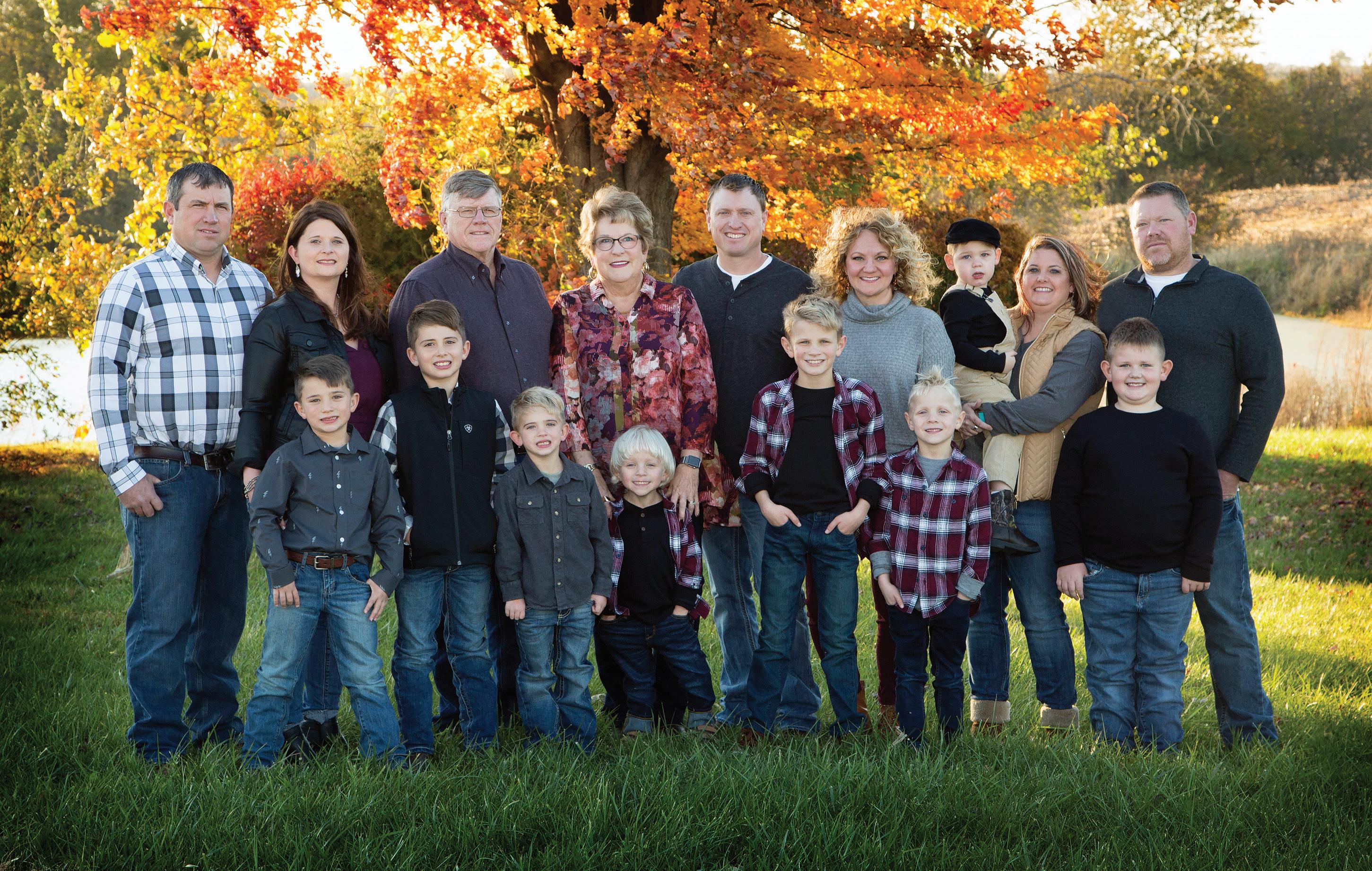
Q Tell us a little bit about your faith journey.
We were both baptized Roman Catholic. Our parents had a very strong faith that they passed on to us. We attended St. Peter Cath olic School in Marshall, Missouri – first grade through eighth grade. We both attended Immaculate Conception Catholic Church in Shackelford, Missouri while growing up, and we were married there on May 19, 1973.
Q
Is your Catholic faith part of your professional identity, either publicly or privately? How is it expressed during the work day or in the professional setting?
We have been farming for more than 49 years, and we rely heavily on the proper weather for our crops. We do pray a lot that God will see us through the ups and downs during the seasons on the farm.
Q
What are some practical ways that you incorporate prayer into your work day?
Marlene likes to say the Prayer of St. Francis of Assisi (Prayer for Peace) often. We also turn to a Prayer for Farmers and Farm Communities by Bob Hostetler, plus many more. Marlene is always praying to Saint Anthony because he is the patron saint of lost things. The prayer goes like this, “St. Anthony, please look around; something is lost and must be found!”
Q Does your Catholic faith influence your interac tions and decisions throughout the work day?
We try to help people that are less fortunate than we are. We participate in the Meals on Wheels program in our community delivering meals to the elderly bi-monthly representing our church, and we do volunteer work to better our community.
Dwaine and Marlene are members of Saint Mary Catholic Church in Higginsville, Missouri.
Joyfully surrendering himself to Jesus
By Marty DenzerSeminarian Eric Wachira’s Year II

is starting at Conception Seminary College, and his happiness
shines in his eyes.
Eric’s parents and older brothers were all born in the East African nation of Kenya. His mother was offered a short-term job in Kansas City around 2000 and loved the city. When she returned home, she persuaded her husband and children to emigrate, and the family moved to Kansas City in 2001.
His father, a nondenominational Christian, wanted his Catholic wife and sons to attend church with him, so they joined a nondenomi national Christian church. When Eric was born in 2002, he was eventually baptized in that church. In 2015, however, his mother decided
she had missed Christ’s Real Presence in the Eucharist for too long. She and her sons started attending St. Andrew the Apostle Church in Gladstone.
Eric and his brothers went to public schools through high school. In the summer of 2015, Eric attended Totus Tuus for teens, a weeklong Catholic summer program, including games, skits, songs and more, run by college students trained to spend their summer drawing children and teens closer to Christ.
“Mom explained a lot to me about what was talked about in Totus Tuus.” he recalled.
Wanting to know more about Catholicism and be a part of it, Eric, by then a high school freshman, attended Rite of Christian Initiation for Adults (RCIA) sessions at St. Andrew’s. “St. Andrew’s Youth Group took me on their shoulders while I was in RCIA. I found a real interest in the [Real] Presence in the Eucharist.” Then, during his sophomore year he discovered a talent and a liking for basketball. He spent many hours dribbling and shooting baskets and playing for his school’s team. His dreams began focusing on the NBA. At the same time, his newfound faith began to falter and hit a low point by the end of his sophomore year. That summer, mostly out of curiosity, he at tended a retreat at Franciscan University in Steubenville, Ohio, with some friends from
the St. Andrew’s youth group. During the re treat, he felt his faith return.
Eric was confirmed in 2018. He had recon nected with the St. Andrew’s youth group, at tending Wednesday night meetings.
In the spring of 2020, he participated in a discernment retreat at St. Gregory the Great Seminary in Seward, Nebraska. Basketball was still on his mind, but after the retreat, he went to the chapel to pray. “I felt at peace,” Eric said, “like God was telling me this, the priesthood, was what he wanted me to do.”
After he returned home, Father Leonard Gicheru, pastor of St. Monica Catholic Church and a family friend, asked Eric how discernment was going, “which surprised me because he’d never spoken of the priesthood to me.”
In August 2020, Eric approached Father Nathan Rueb, then Parochial Vicar of St. An drew the Apostle Parish, asking the priest to be his spiritual advisor. He also started attending discernment meetings at Our Lady of Good Counsel Church. Father Adam Johnson, then Vocations Director, handed Eric an application to study for the priesthood before one of the summer meetings.
He was pleased and grateful when his appli cation was accepted. He started at Conception last August.
Eric is excited as Year II begins. He listed some of his classes: Philosophy, Latin, the Old and New Testaments, Natural Theology, West ern Civilization, and he’s joined the choir “to see if I can sing!”
His family, especially his mother, is thrilled. Eric’s grandparents are visiting from Kenya, and they too are joyful.
Eric hopes to be the kind of priest who would “literally lay down his life for his parish,” and that those he ministers will find joy in their faith. He loves the Sacrament of Penance, “[It’s] kind of Saint John Vianney-like.”
Eric’s favorite prayer, the Surrender Novena, symbolizes his vocation — “Oh Jesus, I sur render myself to you.”
“I felt at peace, like God was telling me this, the priesthood, was what he wanted me to do.”
The Benedictines of Mary, Queen of Apostles, in Gower, welcome women to the life of a contemplative, traditional religious sisterhood.
Learning a
as a religious sisterlife of love
By Marty DenzerSince 2014, the Benedictines of Mary, Queen of Apostles, in Gower, have welcomed women to the life of a contemplative, traditional religious sisterhood. On August 22, the Feast of the Immaculate Heart of Mary, Sister Photina, with her class of seven, was invested as a novice.
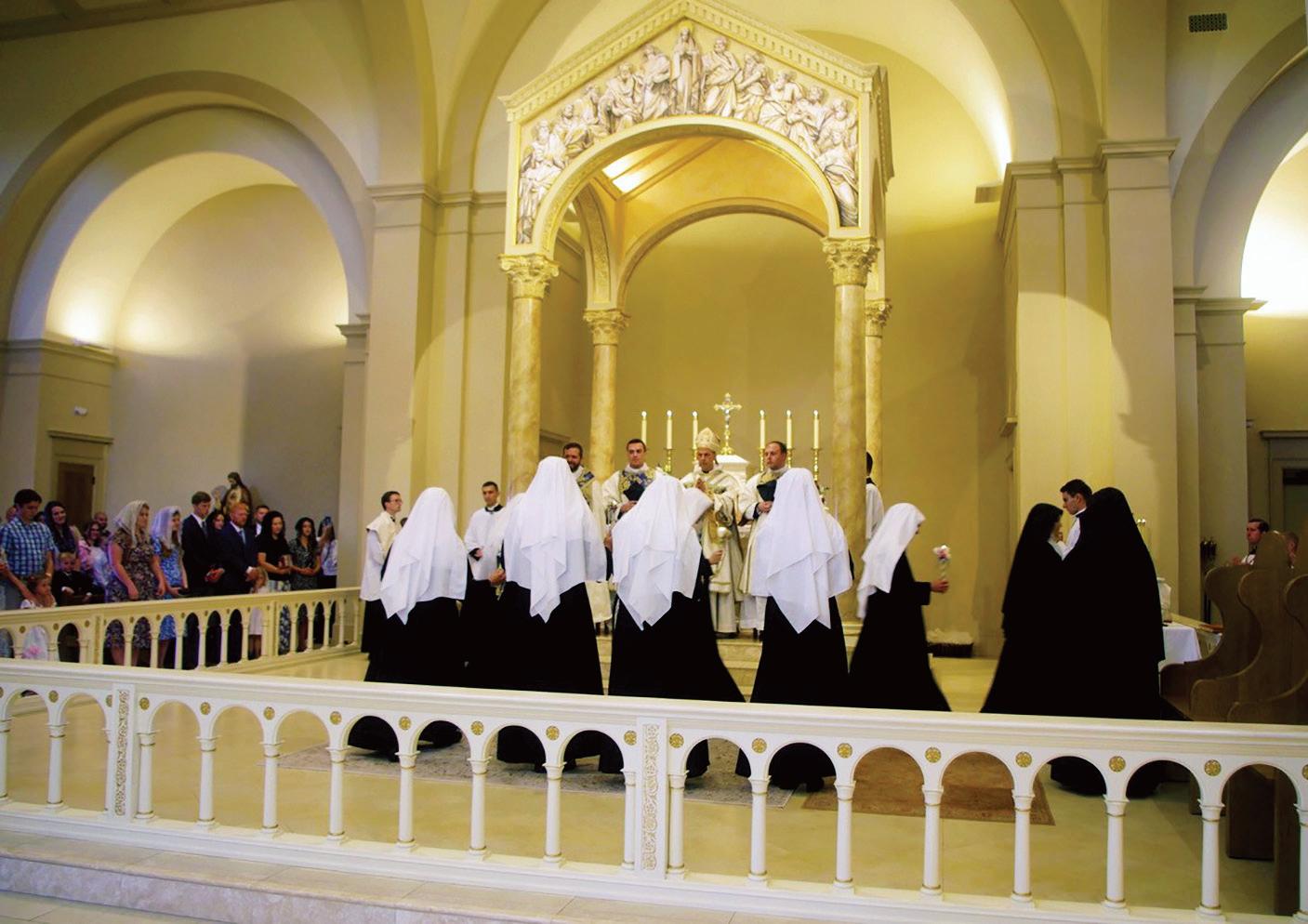
Growing up in Bloomington-Normal, Illinois, she attended Catholic schools before having “the blessing of being able to attend two Catholic colleges.” Although the new novice felt drawn to religious life earlier, during her second year in college, the attraction became a true “want.”
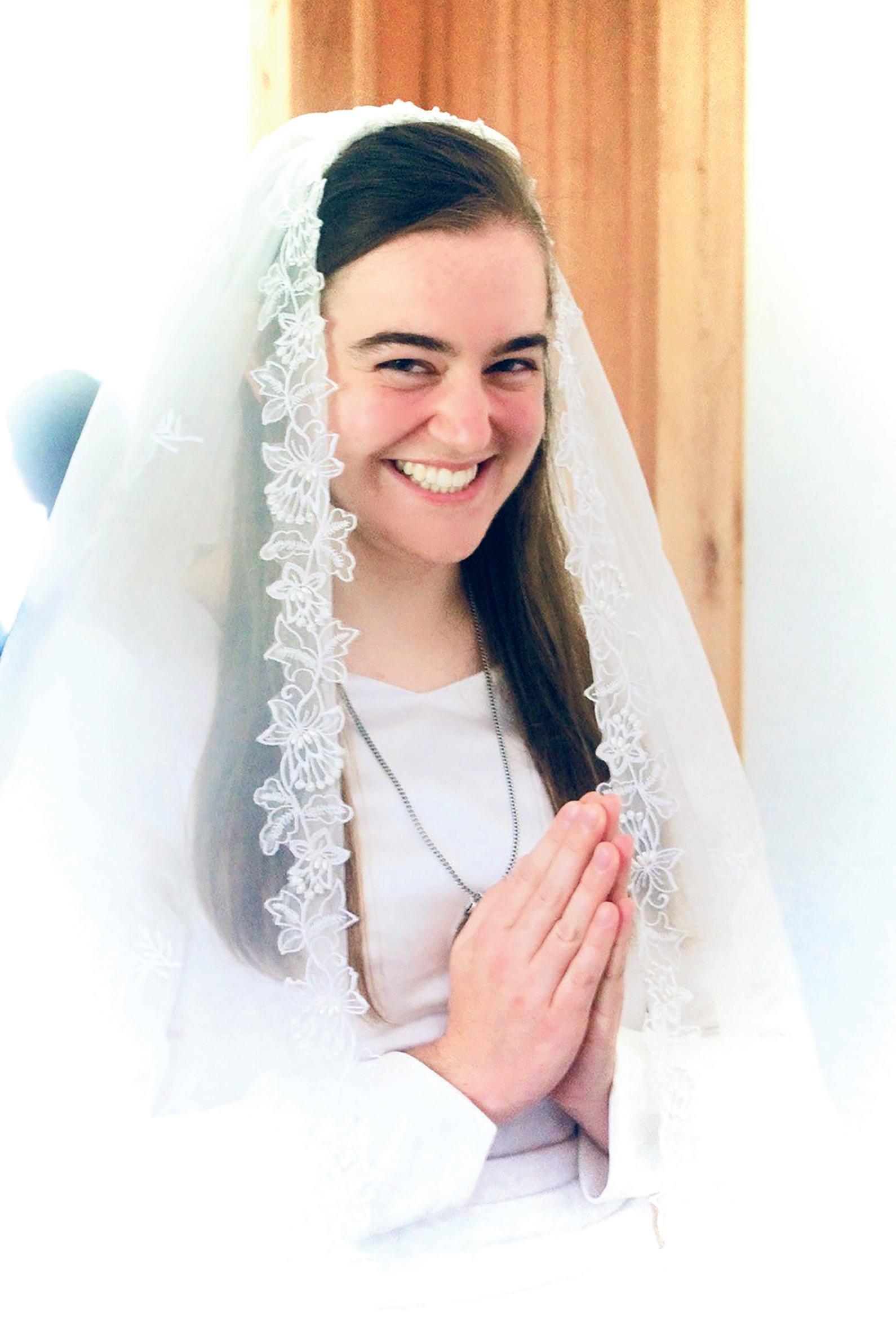
Sister Photina explained, “Before then, it was a vague idea; I don’t think I quite understood that it was actually an option! I had never had any real interaction with Sisters until God clearly put the Dominican Sisters of Saint Cecilia of Nashville in my life at Aquinas University. During my college years with them, I was blessed to study in Italy with a small group of young women and lived on the Sisters’ property. I learned a lot about religious life — Compline and daily prayers — and about our Catholic faith as a whole.”
Several years passed before she “determined that my calling is to traditional, Latin, contemplative religious life. I found our Benedictine Order and entered within a year. I am learning more about religious life here at the Abbey of Our Lady of Ephesus.”
“Now I see that God met me where I was. What immediately got my attention were superficial things — our songs, cows and the ‘farm life,’ being in the Midwest. On a deeper level, I loved the contemplative, cloistered life, especially the Traditional Latin Mass and Divine Office, which I discovered not long before.”
The Liturgy of the Hours orders the Sisters’ days — rise about 5 a.m., Matins, Lauds and Prime, a meal then work. Novices rotate work as signments to gain more experience. Sister Photina works in the kitchen, sewing room, garden or the barn, and she loves each assignment. Terce, Mass, Sext, a meal or work, free time. Praying None is next, then an hour’s recreation time, followed by “quiet time to read or spend time with Our Lord,” followed by supper and work until the bell rings for Compline, “and we say goodnight to Our Lord and Our Lady before lights out at 9 p.m. Days are full and always new,” she said.
“In life, especially consecrated life, we receive infinitely more than we may be ‘giving up.’ First, we have the grace of receiving our vocation from God. Everything we are and have is a gift from God, and life is God giving himself to us. The love in this giving infinitely outweighs anything we might be giving up. Each member of the community in turn gives so much to the other members and those they encounter. I hope to give all of myself in basic, perhaps small things, every day, so that with Jesus’ help, what Saint Paul says may be true: Jesus lives in me instead of me living in me.”
With the help of the Holy Spirit, Mother Abbess gives each Sister a new name in religion.
“It’s beautiful how perfectly each name fits each Sister,” Sister Pho tina says. “Not many people know the name ‘Photina,’ the name of the Woman at the Well. I have such a love for her! With her help and the help of Jesus, I hope to live her name and receive the graces to leave all, to cling to Our Lord and bring others to Him as she did.”
For those struggling with vocation discernment, Sister Photina says to be patient, especially with yourself.
“Always trust in God with confidence that he will help you determine his will, when the time is right.”
Holy
groundCatholic Cemeteries provide a sacred home for love and loss
 By Ashlie Hand | Photos by Megan Marley
By Ashlie Hand | Photos by Megan Marley
 Kenny Gilbert, General Manager of Catholic Cemeteries in the Diocese of Kansas City-St. Joseph, compares the grave sites he oversees to rooms in a home.
Kenny Gilbert, General Manager of Catholic Cemeteries in the Diocese of Kansas City-St. Joseph, compares the grave sites he oversees to rooms in a home.
Kenny Gilbert already seems settled, comfortable and at peace in his new role despite being just 21 days into the job. Sitting in his office, one gets the impression he is eager, full of optimism and exactly where he is supposed to be. The journey to General Manager of Catholic Cemeteries may have taken a little longer than he expected, but there’s no question about his gratitude and relief at finding himself feeling right at home.
“God’s name is written all over this opportunity for me. It was an answer to a prayer,” Kenny says. He explains being eager for a change after 30 years in the convenience store industry, where he had worked his way up to managing a network of more than a dozen stores for Trexcon Incorporated.
Not only did Kenny pray for himself, that his job search would be fruitful, but his wife and many members of his parish at St. Robert Bellarmine in Blue Springs prayed for him as well.
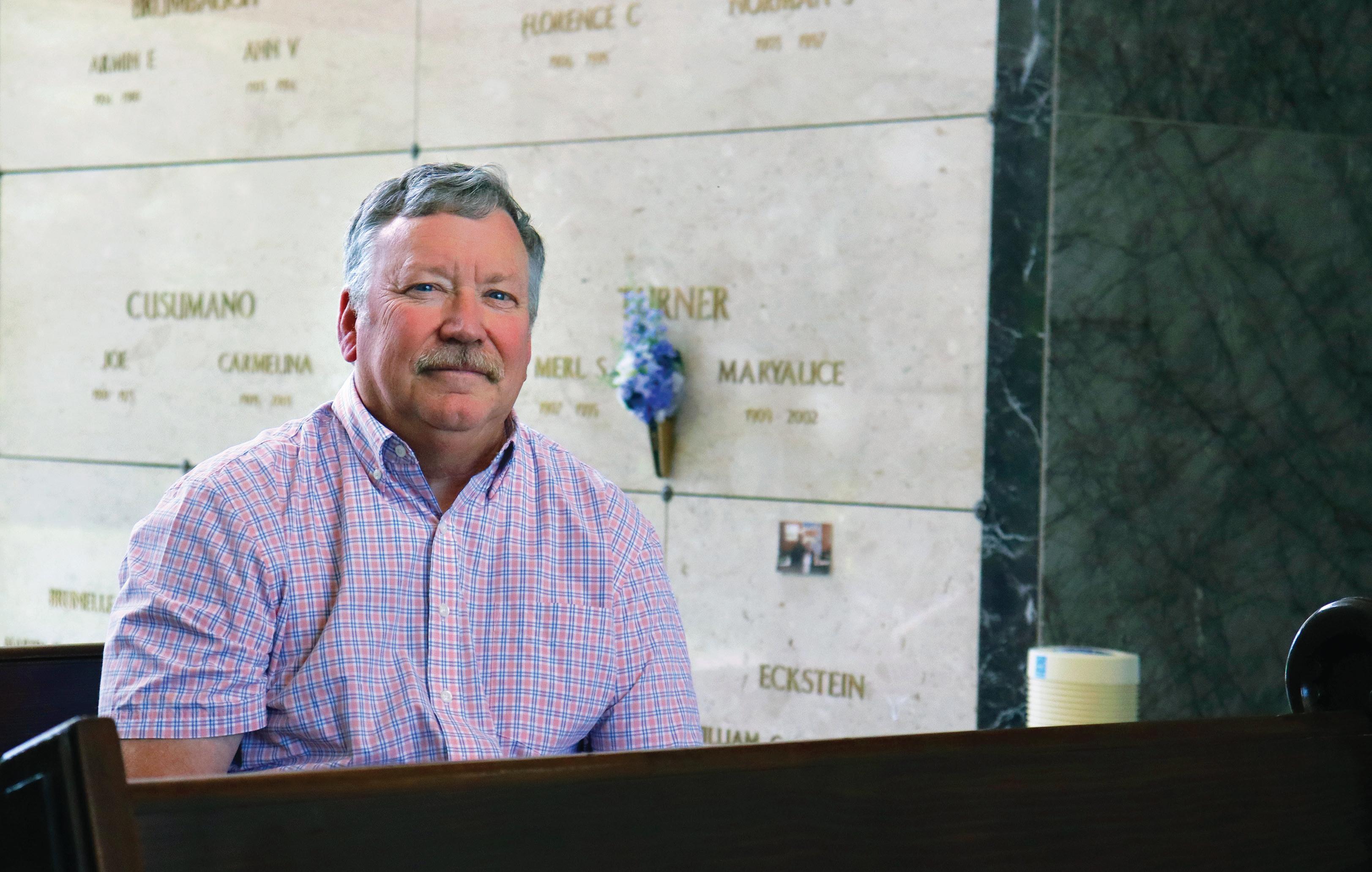

“For someone who is at a later stage of their career, this is the change that I was really hoping for,” he said. “I really wanted to work for the diocese and with people who share my faith. This job was the perfect fit with my experience.”
Working in a cemetery may not be at the top of the list of dream jobs for everyone, but for
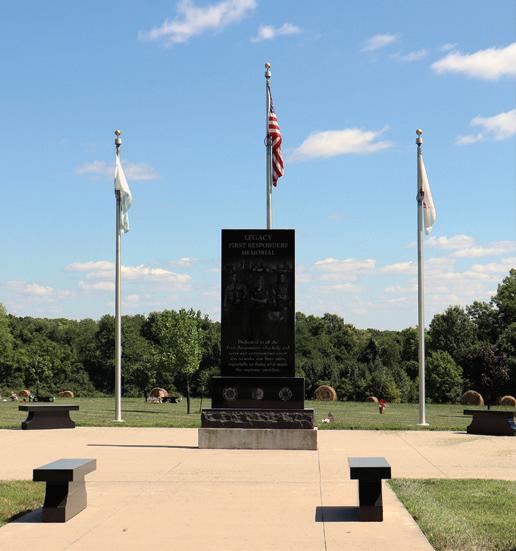
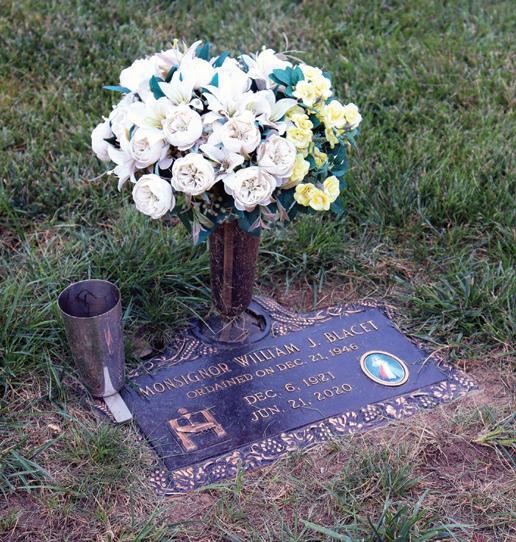
“This is holy ground that has been blessed. That’s why our Catholic cemeteries are different than others in our area, and that makes it a special place for those we are burying.”
— KENNY GILBERTFirst Responders Memorial at Mt. Olivet Cemetery in Kansas City. A statue of Jesus, the Good Shepherd, stands watch over the sacred ground of Mt. Olivet Cemetery in Kansas City, Mo.
Kenny Gilbert, General Manager for Catholic Cemeteries is a dream job come true.
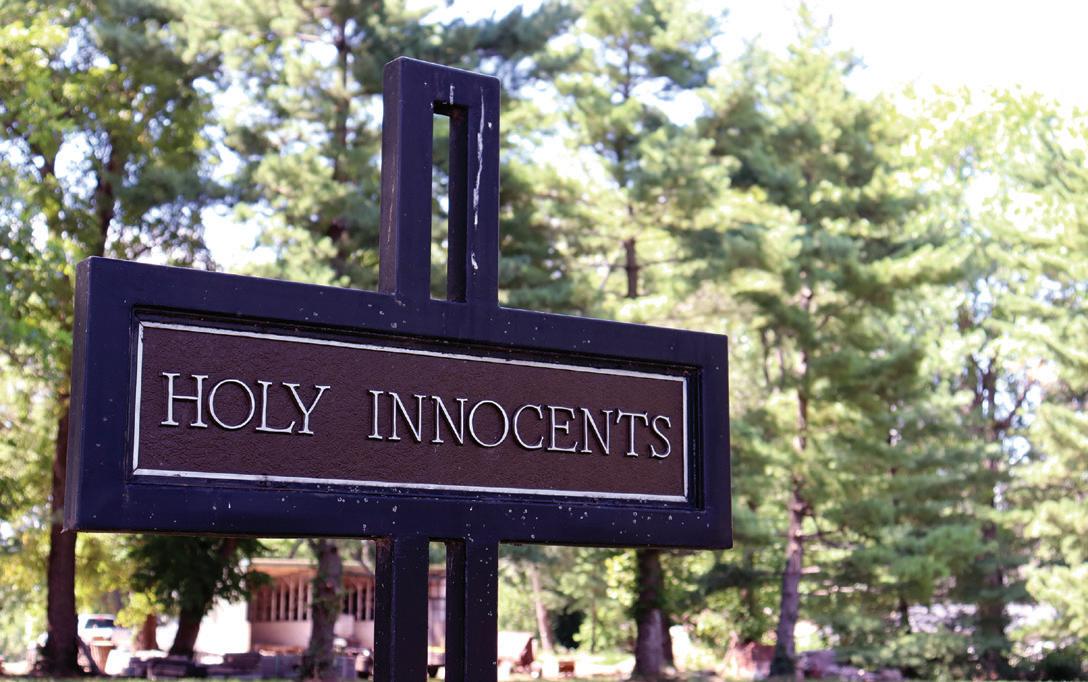
“I’ve always felt comfortable at a cemetery,” he said. “I started going to Mt. Olivet in St. Joseph at seven years old when my older sister passed away, and several years later my older brother passed. The cemetery always felt like home.”
Kenny has a unique gift for remembering where everyone in his family has been buried during his lifetime. He pictures them like rooms in a house where members of his family now live.
“The cemetery isn’t a sad place for me,” he says. “It’s where my family is.” Catholic cemeteries are special in another way, as well.
Funeral services evolve
Mount Olivet Cemetery and Resurrec tion Cemetery in Kansas City will soon be offering preconstruction sales for the new addition to the Holy Family Mausoleum. Demand for indoor mausoleums and nich es for cremated remains has maxxed out the current availability at both cemeteries. The project involves an expanded chapel area in addition to new indoor mausole ums and niches.
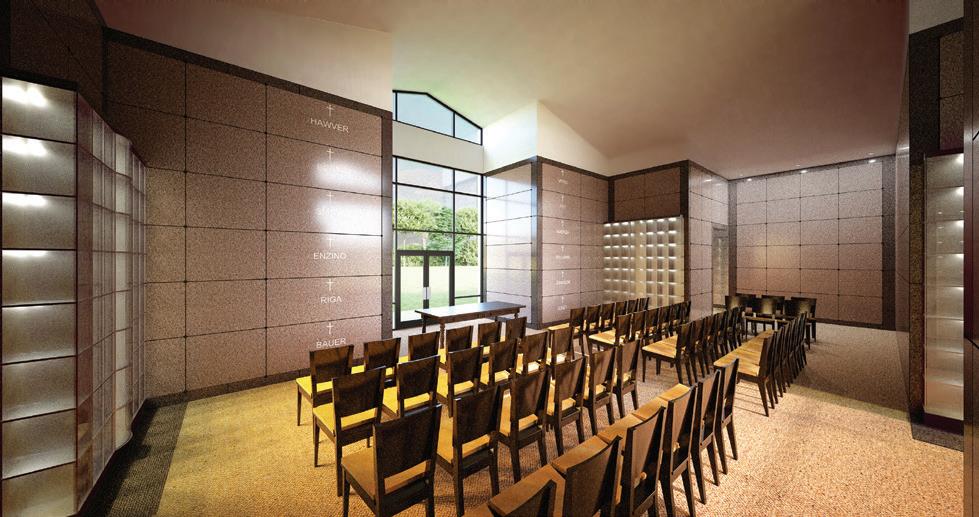
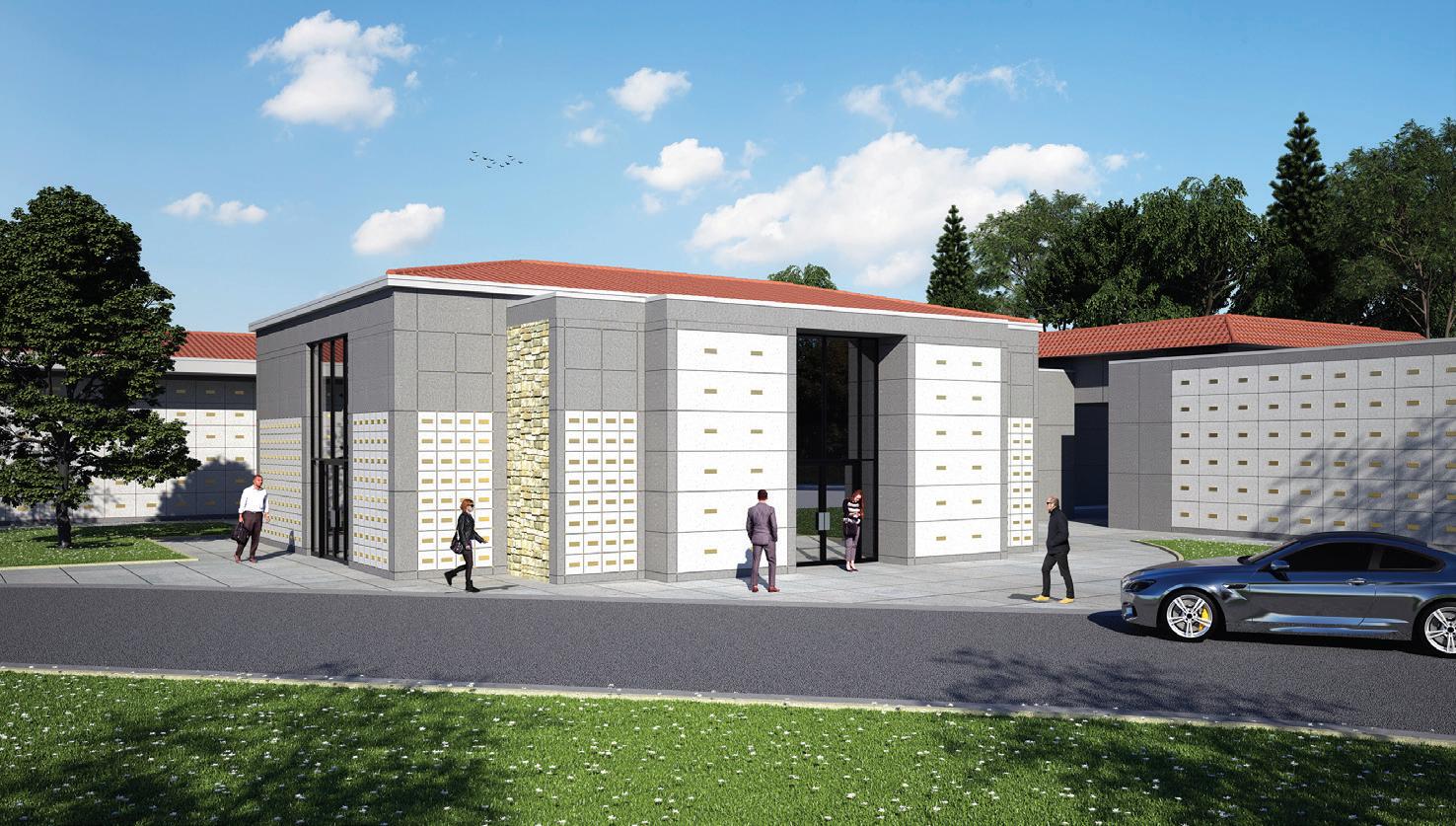
Charles Passantino, Managing Part ner of Catholic Cemeteries and owner of Passantino Bros. Funeral Home, said, “The growth of the Kansas City Northland opens many opportunities for Resurrec tion in particular. The mausoleums will focus on the evolving nature of funeral services, including several options for cremation-related products and services, and include an indoor chapel we are able to utilize to offer families choices we have never before had available.”

“This is holy ground that has been blessed,” Kenny explains. “That’s why our Catholic Cemeteries are different than others in our area, and that makes it a special place for those we are burying.”
The Catechism of the Catholic Church teaches that “The works of mercy are charitable actions by which we come to the aid of our neighbor in his spiritual and bodily necessities.... The corporal works of mercy consist especially in feeding the hungry, sheltering the homeless, clothing the naked, visiting the sick and imprisoned, and burying the dead.” (CCC 2447)
From Kenny’s perspective, “Burying the dead allows us to get closer to those we can no longer see, and being closer to them is comforting. If I had an issue that’s where I would be.”
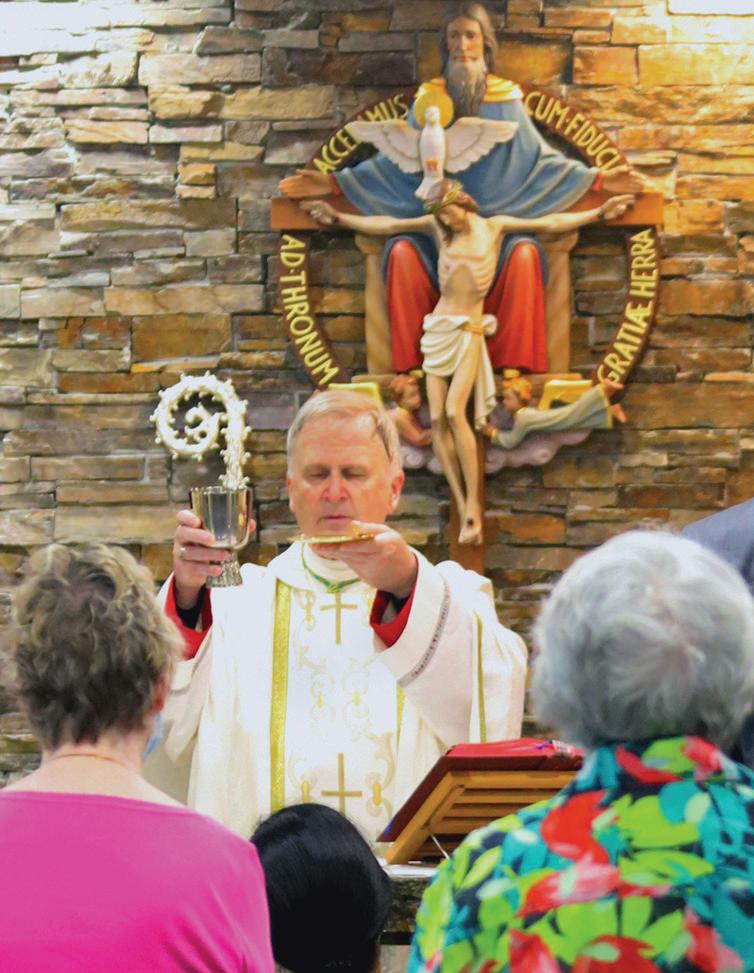
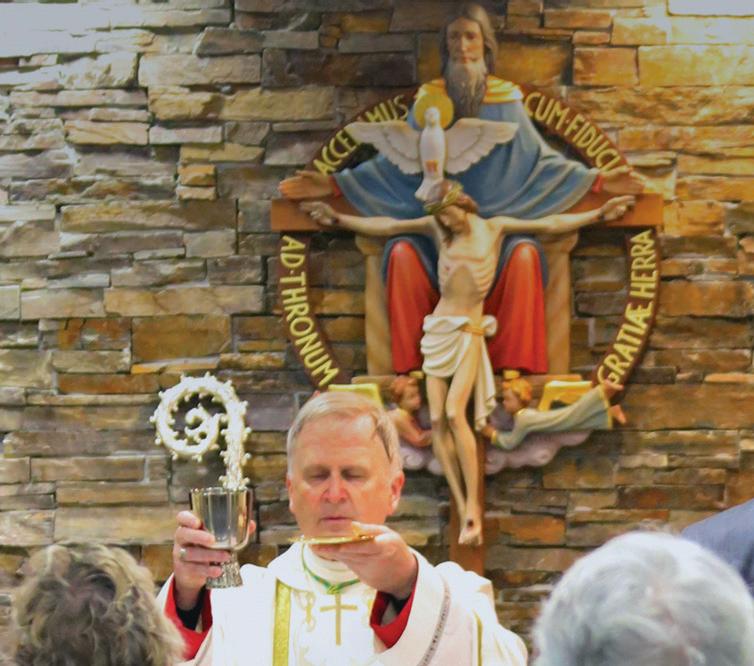




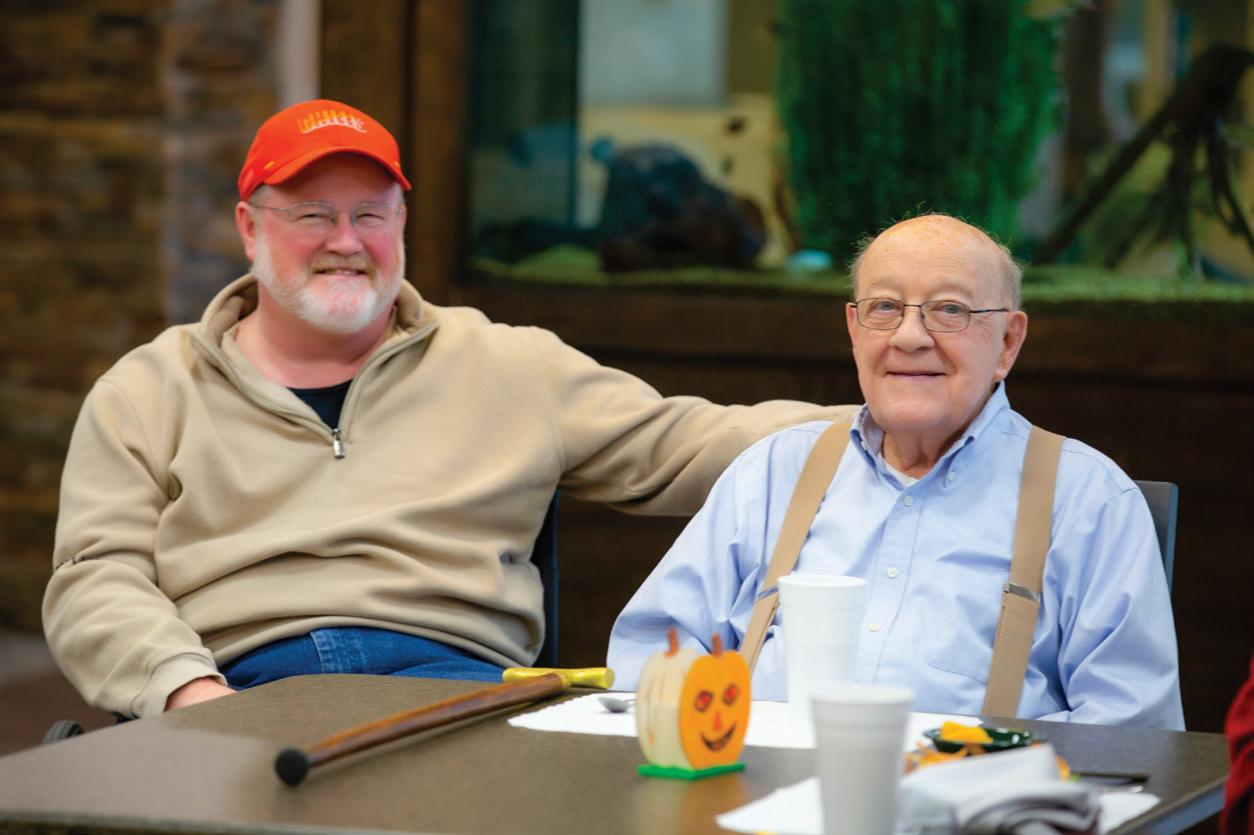




Labor
love
By Megan MarleyFinding the newborn Jesus in adverse perinatal diagnoses
Alexandra’s House welcomes the broken and unwanted ‘least among us’ in society, which is echoed in the reclaimed religious art decorating the house.
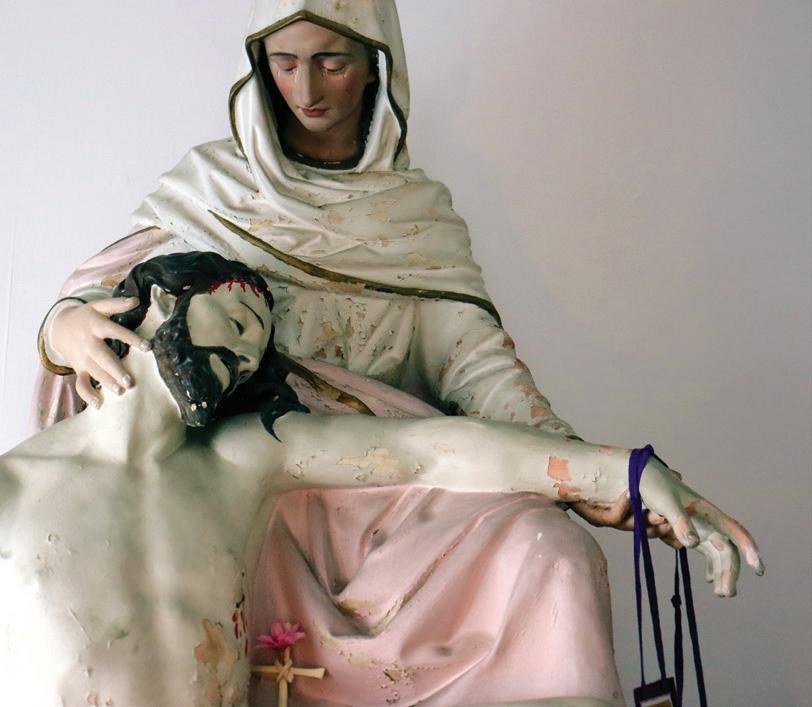
Alexandra’s House is one of the first ministries to provide practical support for perinatal hospice and loss of a baby in the Kansas City area. Its volunteer, peerled community is rooted in faith but serves believers and nonbelievers alike in meeting time-intensive needs the medical field can’t fulfill on its own.
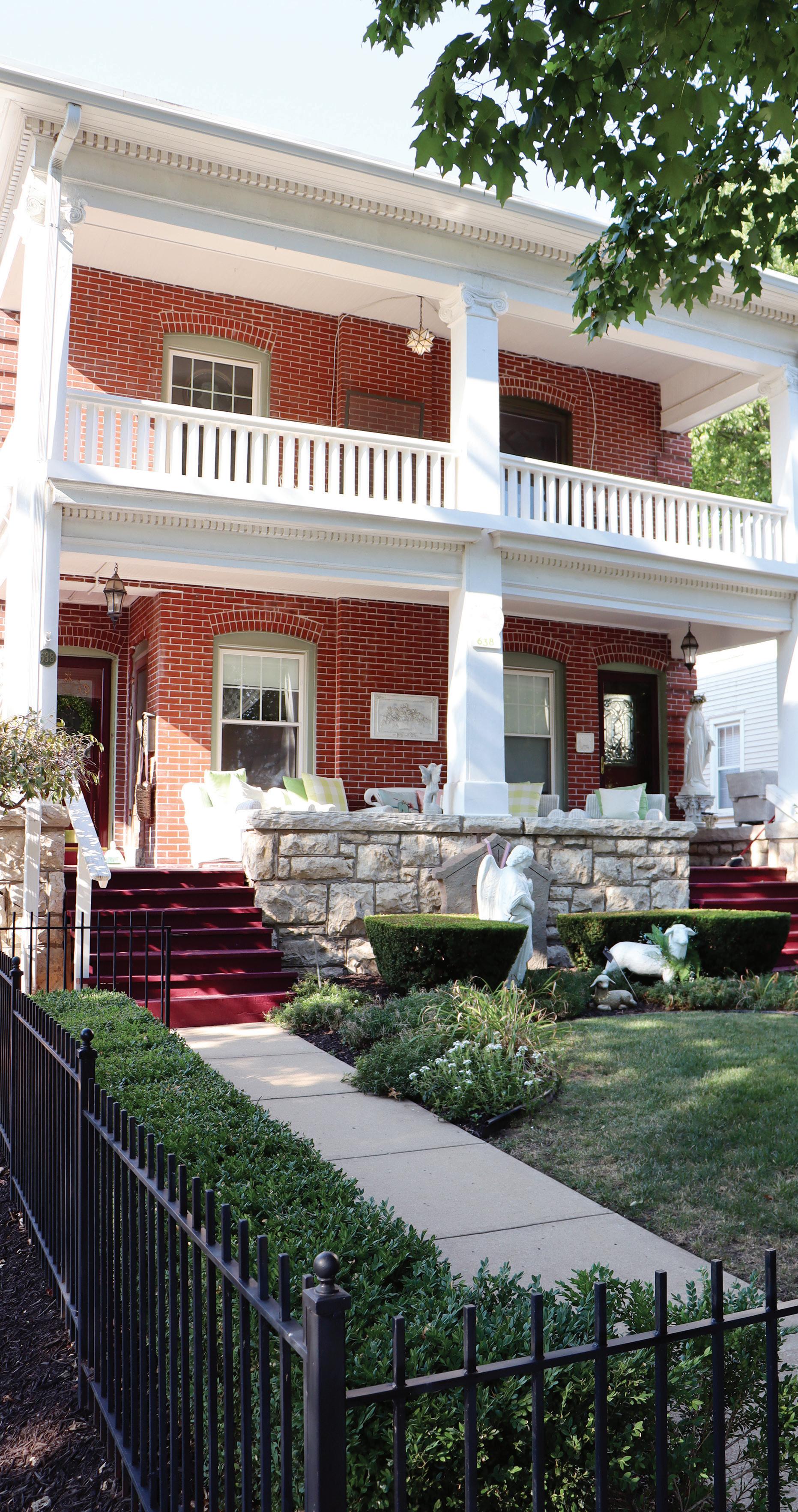
When little Alexandra began her short six-week life on the feast of Our Lady of Guadalupe in 1994, Patti Lewis was a cardiology nurse and had just ap plied for medical school. As often hap pens when you’re the ‘medical person’ in the family, Patti assisted in navigating her niece’s diagnosis with a rare and fatal genetic syndrome.
“She was in the [neonatal intensive care unit] for a month, and the neona tologist just came to me and said, ‘you know we can’t cure her, so just take her home and call the funeral home when she dies,’” Patti recounts. “I remember thinking, surely there's another family in Kansas City who’s taken a baby home to die. Why couldn't somebody point us to them? Little did I know that that's exactly what I’d be called to do.”
As the family grieved Alex’s death, Patti grew in awareness of a call placed on her heart to help others with similar
loss. The term (and practice) of “peri natal hospice” didn’t really exist at the time. But that didn’t stop the founding of this very special place for very special babies: Alexandra’s six-fingered hand print is the emblem of the mission, and her headstone is its cornerstone.
The first very special baby came in 1999. Today, the Little Scala Sancta (or Holy Steps) in Alexandra’s House wit nesses the literal and communal labor of love by families and volunteers.

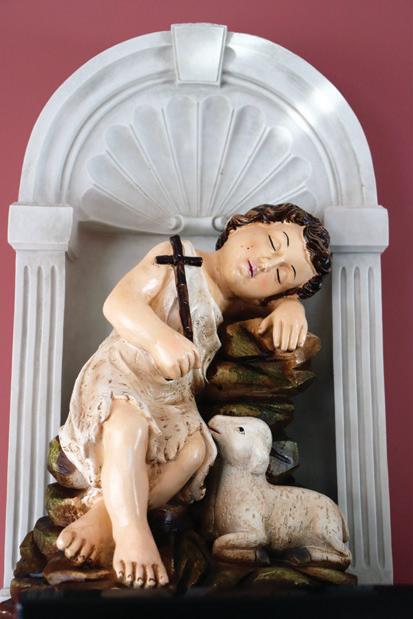

“These babies aren’t perfect, we’re not perfect and there’s beauty in that, in these little saints,” says Patti. “I see the new born Jesus in every one of our babies. He is the first who was born to die.”

Parents and families coming to Alex andra’s House first have a long conver sation about their needs, fears, what to expect, how to maintain connection as a family and anything else that arises. Patti then serves as a “matchmaker” to peer mentors with similar backgrounds or diagnoses for accompaniment as desired. There are also ethicists and medical volunteers who can share their experience to alleviate fears. The House also offers a comforting residential space located near several area hospitals for families to stay leading up to birth and provides a place to bring their baby home for his or her final days.
Parents can get special bonding so nograms to see their little one’s toes and
fingers, funny faces and thumb suck ing. Photographs, footprints and other mementos at birth are available, as are burial gowns. There are also in-person and online support groups, a prayer intention team and commemorative events for individuals and the wider loss community.
Alexandra’s House also accompanies moms with severe health issues, and those with otherwise normal pregnan cies ending in a stillbirth or their baby’s unexpected death. Women who lost ba bies 50 years ago can come for a chance to grieve. There are also connections to external infertility and post-abortive groups as well.
All services are offered for free and are 100-percent volunteer and donation supported.
“Wherever you end up without a baby, we want to help,” Patti concludes. “This whole mission is building a cul ture of love.”
Many of the babies loved at Alexan dra’s House have diagnoses where abor tion is suggested ‘so they don’t suffer.’
“There's certainly a great suffering of the heart, that's for sure.... I’ve been to the births of a lot of these babies, and often there just isn’t a need to medicate them. They're quiet, comfortable and very peaceful, without intervention,” Patti explains. “These are high touch, low tech babies — they just need to be loved.”
Visit alexandrashouse.com for more information.


Interested in learning more about perinatal hospice from a doctor’s perspective? Read “The Perinatal Hospice: Allowing Parents to be Parents” by Dr. Byron C. Calhoun on the Charlotte Lozier Institute website, lozierinstitute.org/ the-perinatal-hospice
“All the major hospitals here have teams now, so when someone comes in with a seri ous diagnosis, they have teams of doctors, social workers and nurses who meet with these people and help them prepare in the hospital. Now they're get ting much, much better care.”
The mission of Alexandra’s House is very much in keeping with respecting the dignity of every human person, no matter their stage or walk of life.
“It’s such a privilege to be invited to walk this very sensitive, painful time with them. I see such transformation in people through these experiences,” says Patti. “The babies are vessels in a holy way, and that's what motivates me to continue every day: the breathtaking beauty I see in these broken hearts.”
feature
All Ways Are
By Bridget Locke Photos contributed by St. Monica ParishBEAUTIFUL
A little more than 30 years ago, the National Black Catholic Clergy Caucus of the United States established November as Black Catholic History Month.
Similar to Black History Month, Black Catholic History Month was launched to ensure that the unique needs and too-often-overlooked contributions of Catholics of African descent are acknowledged with intention and consistency.
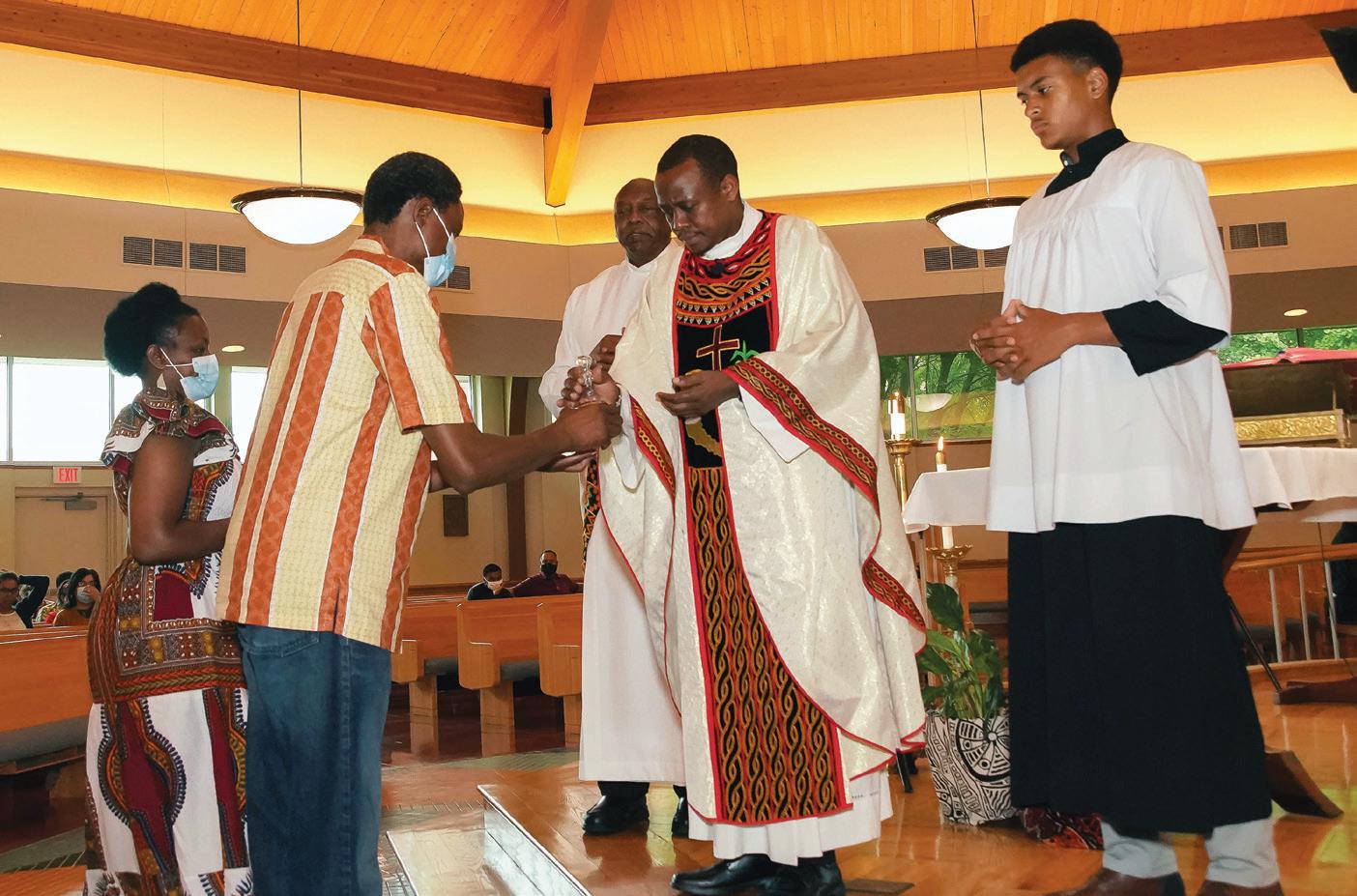
The month of November includes several commemorative days and anniversaries honoring Catholics of African heritage:

• Nov. 1: All Saints Day, which is commemorated as an opportunity to honor the lives of all saints, including hundreds of saints of African descent in the first 300 years of the Church.
• Nov. 2: All Souls Day, which encourages the re membrance of all the departed, including Africans lost to cruel treatment in the Middle Passage crossing of the Atlantic Ocean.
• Nov. 3: The day on which Martin de Porres became the first Black American saint. He was canonized by Pope Saint John XXIII on May 16, 1962.
• Nov. 13: The birthday of St. Augustine in 354 A.D., who was the first Doctor of the Church from North Africa.
• Nov. 20: The death of Zumbi of Palmares in 1695, in Brazil, South America, who was the founder of a free state for Black people.
And, perhaps the most important question: why should everyone care about and commemorate Black Catholic History Month? Because within the Black Catholic experience lives a sense of resilience and pride that is not always discussed — but should be.
SAME JOURNEY, DIFFERENT ROADS
Though there is a strong, holy cord that binds all Catholics together in the faith, there are stark differences in how people experience community within the Church. This is particularly true of Black American Catholics, when compared to their White and Hispanic counterparts. A 2022 Pew Research Cen ter study, seeking to capture the diversity of Black American religious life, revealed that, while there are approximately 3 million Black Catholics in the U.S., they comprise only a small share of Black adults (6 percent) in the country, and an even smaller share of Catholic adults (4 percent) in the Church.
As a result, Black American Catholics are much less likely than White or Hispanic parishioners to worship in a place where most people share their race or ethnicity. According to the same study, only 25 percent of Black Catholics who attend Mass at least a few times a year report typically going to a Mass where most other attendees are Black—compared to 80 percent of White Catholic church goers, who worship where most attendees are White, and 67 percent of Hispanic Catholic church attendees, who worship where most are Hispanic.
Father Leonard Gicheru, pastor of Kansas City’s historic St. Monica Catholic Church, can relate.
Did you know:
There are many church leaders of African descent who are on the journey to Sainthood. Visit www.usccb.org/ committees/african-american-affairs/ road-sainthood-leaders-african-descent to learn more about them.

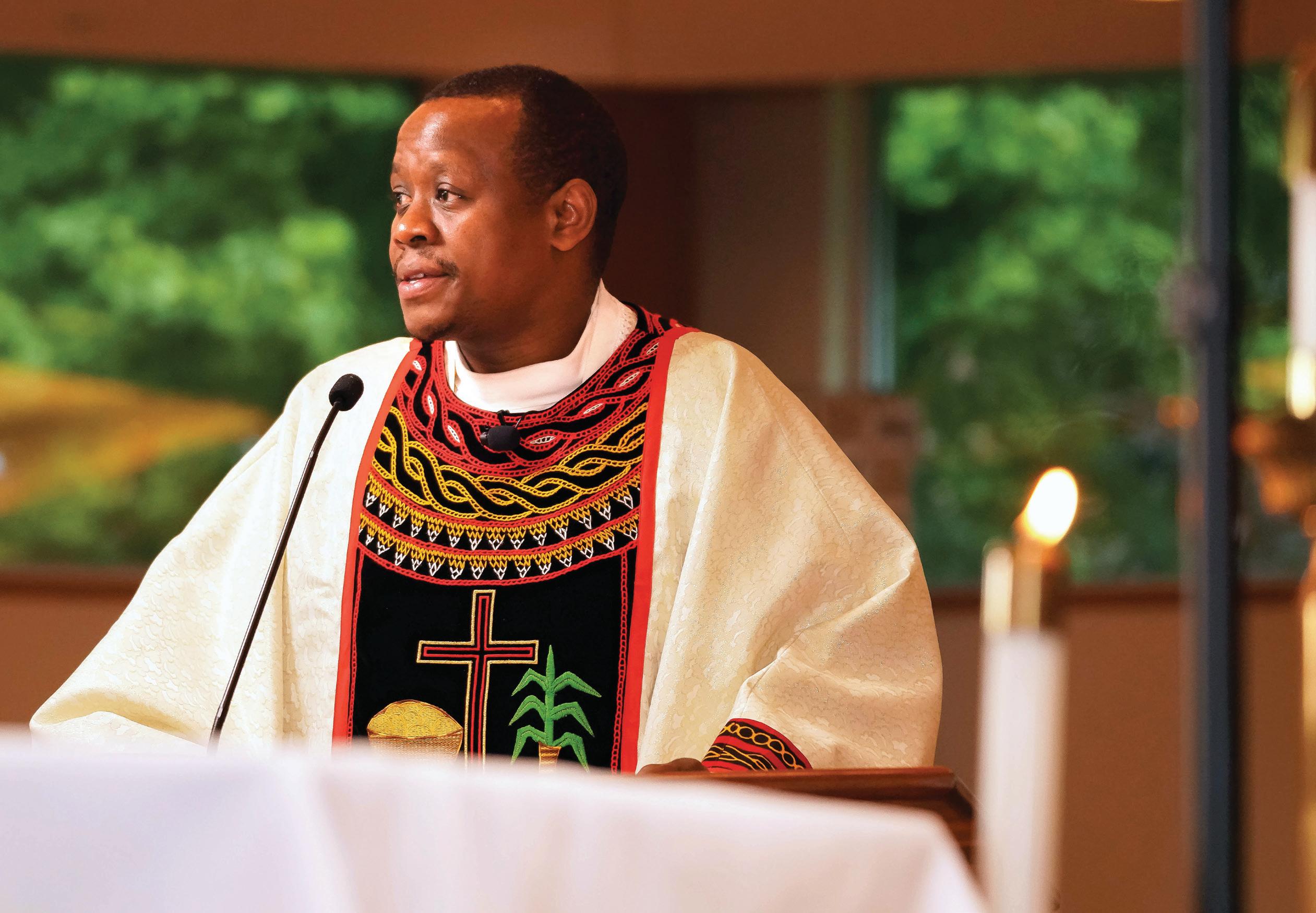
“When I left Kenya and came to the United States, I grew accustomed to being only one of a few Black people in most parishes,” he said.
However, his experience completely changed in 2017 when he was assigned to St. Monica.
IDENTITY MATTERS
With the distinction of being Kansas City’s first Catholic mission founded for African Americans in 1910, St. Monica Catholic Church provides a unique experience: the liturgy, the prayers, the choir (known throughout the city for their soulful approach), and the interactions between parishioners are likely different from what most others in the diocese experience at their parishes.
“At St. Monica, identity is very important. What I really appreciate is how our parishioners take pride in being who they are; they embrace their ‘African-ness’ as well as their American identity,” said Father Gicheru. “We are careful to acknowledge people in the Black community who have made notable contributions to society,” Father Gicheru continued. “We celebrate Black history every Sunday.”
When asked his opinion about the most important con tributions of Black Catholics to the Church, Father Gicheru
lists many, but considers leadership in social jus tice as one of the most important.
“With the recent social reckoning after the mur der of George Floyd, lots has happened. The larger Church is listening and joining in the fight against injustice like never before. However, many of the social justice efforts have been delivered through the efforts of Black Catholic people. Over the years, I believe that we have led the way.”
Though it is important to commemorate the accomplish ments and understand the experiences of Black Catholics during the month of November, recognizing the work of every brother and sister in the faith all year long is just as important. Black Catholic history is Catholic history. The Black Church experience is the Church experience. Though there are many different roads, all Catholic people are on the same journey to a more personal, communal relationship with God the Father through his Son, Jesus Christ.
“There is no one way of being Catholic,” said Father Giche ru. “All ways are beautiful.”
The Importance of Funerals
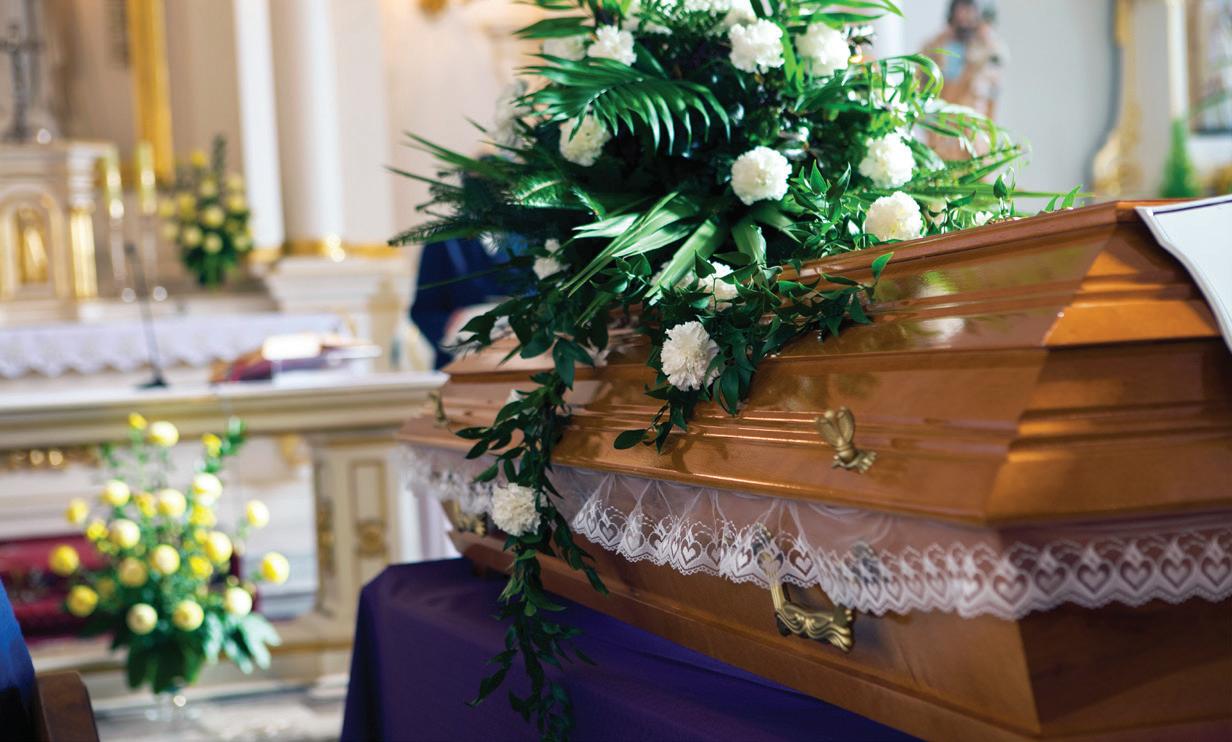
It seems to be a disturbing trend these days: more and more families are opting out of traditional funerals and choosing to do a service at the funeral home or just at the gravesite. They give various reasons: traditional funerals cost too much, they are too long, they are an inconvenience or they just want to get over the loss as quickly as possible and get on with their lives. They may think they are taking the easy way out, but I think it will make things more complicated in the months and years to come because they have taken a shortcut in the grieving process.
When death comes knocking on our door, we do what we always do as Catholics: we celebrate the familiar ritual of the Eucharist because words often fail us in this moment of loss.
EL DIA DE LOS
MUERTOS
Father Matthew Brumleve is the Pastor of St. Patrick’s Parish in Kansas City
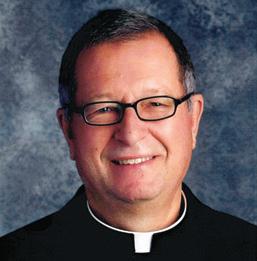
We bring our loved ones to the place where, Sunday after Sunday, we remember and celebrate that light is stronger than darkness. That love is stronger than hate. That life is stronger than death. And that for those of us who believe, when we get to the end of our earthly lives, life is changed, not ended.
So, through songs, prayers, scriptures; with sights, and sounds, and smells; through pic tures, and stories; through laughter, tears, and hugs — all within the context of our faith — we help people move from the physical presence of their loved one to a presence in memory. This is what a Catholic funeral is all about.
Noviembre es un mes importante para los mexicanos, y con el paso del tiempo para Latinoamérica, y hermanos de otras lenguas extranjeras, ya que en este mes se celebra “El Dia de los Muertos.”
El Dia de los Muertos se celebra la víspera del Dia de todos los Santos. Esta celebración es originaria de la época prehispánica. En ese periodo, muchas etnias mesoamericanas rendían culto a la muerte. Entre ellas están los mexicas cuyos dioses encargados de definir el destino de las ánimas eran Mictecacíhuatl y Mictlantecuhtli. Ambos eran señores del Mictlán o “lugar de los muertos”. Sin embargo, para llegar allí, las almas debían lidiar y sortear una serie de obstáculos para finalmente conseguir el descanso eterno.
Par Diacono Juan GarcíaEl Mictlán estaba dividido de acuerdo con la manera en la que murieron. Por ejemplo, a la Tonatiuh Ichan —casa del sol — entraban aquellos guerreros que habían muerto en el campo de batalla. Otro sitio era el Cincalco, casa del dios Tonacatecutli. A este lugar iban quienes murieron siendo infantes pues al ser tan jóvenes se les consideraba inocentes.
Para recordar a los muertos se les suele poner un altar, es muy común colocar en él retratos de las personas amadas que ya no están entre nosotros.
En la parroquia de San Anthony, celebramos esta fiesta anual, donde los feligreses pueden traer la fotografía de sus seres queridos, y ponerlas en el altar, y así continuar con esta tradición.
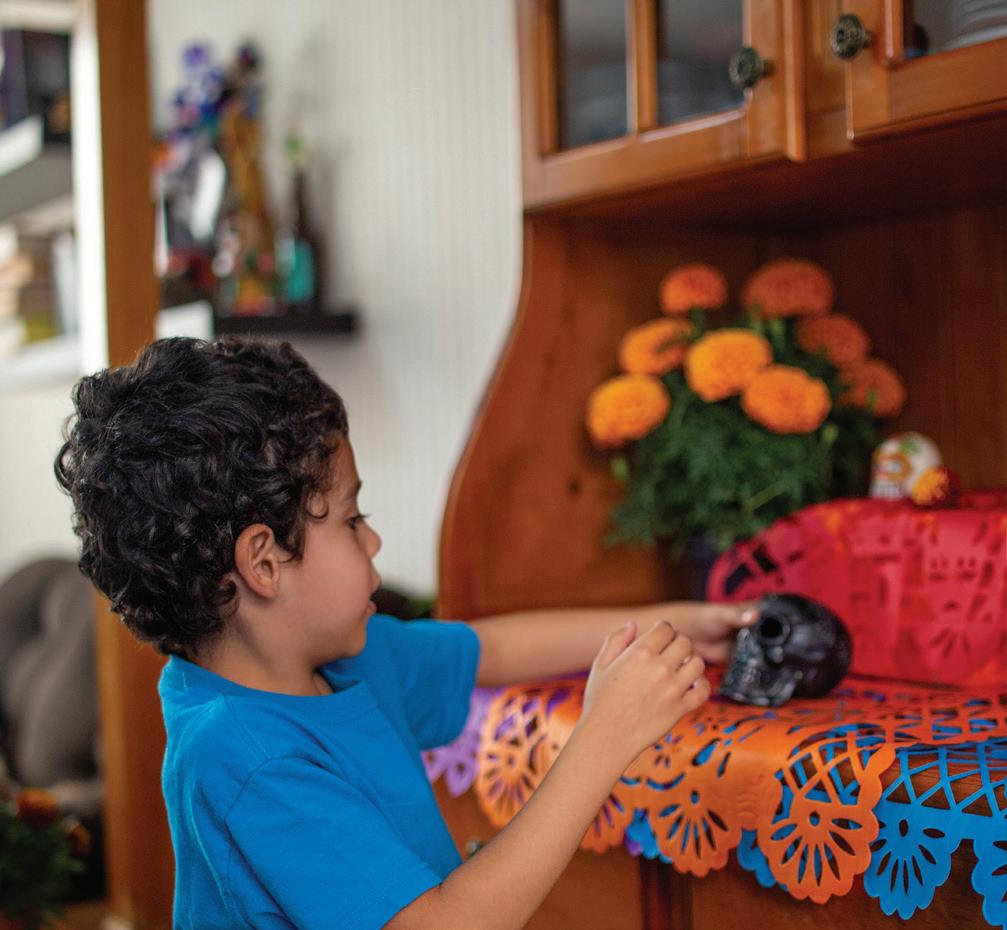
“Let all guests be welcomed as Christ.” -Rule of St. Benedict
The Conception Abbey Guest Center creates a space where you can reconnect your relationship with God and others. We invite you to participate in our upcoming retreats.

Find the perfect retreat for you at conception Abbey

• Silent Retreat: Reconciliation and Eucharist | November 4-6
Calligraphy Retreat: Continuation of Lectio Divina | November 11-13
Silent Retreat: Advent | December 2-4
Icon Retreat | January 13-15
Liturgy of the Hours Retreat | February 17-19
Silent Retreat: Lent | March 3-5
Palm Sunday, RCIA, and Adult Faith Renewal Retreat | April 1-2
Triduum Retreat: Holy Thursday, Good Friday, Holy Saturday and Easter Sunday | April 6-9
Read these full retreat descriptions and more about Conception at www.conceptionabbey.org/guests
National
The United States has a new cardinal, Robert W. McElroy of San Diego, California. Cardinal McElroy is one of 20 new cardinals created at an August 27 consistory. There are now 226 cardinals in the world, with 132 eligible to vote for a papal successor in a conclave. Learn more on VaticanNews.va
Pope John Paul I was beatified in early September, moving closer to sainthood. Known as “the Smiling Pope,” Blessed Pope John Paul I died only 33 days after being elected pontiff. Find ‘Nine things to know about John Paul I’ on CatholicNewsAgency.org
Catholics are renewing their focus on helping pregnant women and babies after the U.S. Supreme Court ruling that overturned the federal right to abortion given by Roe v. Wade nearly 50 years ago. Archbishop José H. Gomez of Los Angeles recently blessed a new convent-turned-shelter for homeless pregnant women, and Bishop Albert Zuroweste of Bellville is selling the episcopal mansion to contribute to a diocesan maternity fund for expectant mothers. Locally, a former convent has been renovated into St. Mary’s Home for Mothers (smhfm.org), which serves homeless, pregnant women and their children. Learn more about ongoing pro-life news on CatholicNewsAgency.org, and local pro-life resources and initiatives at respectlifekcsj.org
parenting
familyA beautiful
Karen Ridder
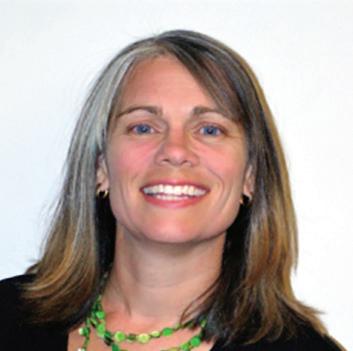
is a parishioner at St. James Parish in Liberty and a convert to the Catholic Faith. She graduated from the University of Missouri School of Journalism and has written for numerous publications in the Kansas City area. Karen and her husband Jeff have three sons and a daughter.
“You have a beautiful family,” they say.
I think to myself. “Why yes, I DO think they’re pretty good looking. Thanks for noticing.”
That’s normal, right? Every mama thinks her babies are beautiful.
I share the comment though, not out of hubris or vain conceit, but because it has occurred to me that the “beauty” people are talking about isn’t about looks at all.
It’s about something else — something far more valuable, and it is something we all have.
What is beauty after all?
I mean, my children are of at least average good looks, but truly they aren’t the most well dressed or best kept. Our lives are often a mess. There’s a lot that isn’t beautiful there. People offering that compliment don’t see how much hard work it has been. They wouldn’t think that was beautiful at all. They can’t possibly know the uncertainty, the worry, the hours of research and sacrifice poured into this life of parenting. They don’t see the disappointments, the fights, the struggles. They don’t see the talks, the hurts, the loss of opportunity, money, time.
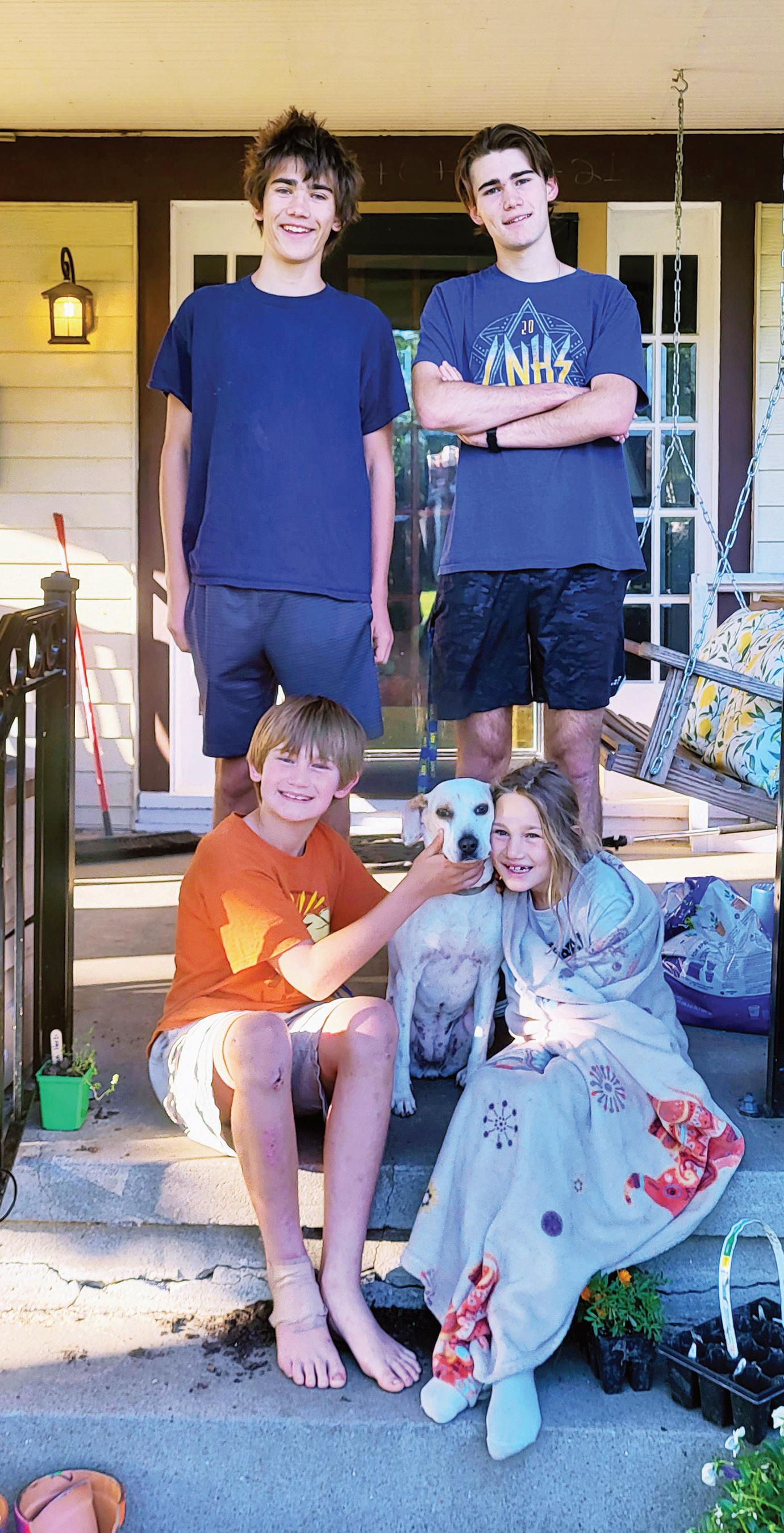
They can’t. It would be impossible. Right?
Well, maybe not. Maybe, that is exactly what they are seeing.
No, they don’t know what percolates behind the scenes, but they are seeing the product of it. The product of my mothering. The product of my marriage. The product of a life dedicated to those four pairs of shining eyes and a man who loves me much more than I deserve. The product of a life crying out to God — often.
I’d like to think that what people find beautiful in the faces of my family is love. These five people are fiercely loved, sacrificially loved, imperfectly loved, yes — but loved still. Perhaps, that is what makes them seem beautiful.
This is the point. We are all beautiful in this way. No matter our family situations, as children of God, we have the same beautiful mark of sacrifice written all over us. We are covered in the blood of Christ and no matter how many faults cause us to stumble or how much ugliness we cross through — we are beautiful.
So, it’s simple. When people tell me my family is beautiful, I see Christ. Through his eyes, they are right: my children are beautiful.
And if today it doesn’t seem beautiful, remember your brother Jesus already proved it wasn’t going to be easy. Just glance at a crucifix to know that truth. Easy isn’t actually beautiful. I mean, it may look pretty, but “pretty” is something different, and we all know it.
Stand proud. Shine your light. Cry out to God.
Remember, no matter what — you have a beautiful family.
Single People, Vocation, and Marriage
It is good when Catholic parishes emphasize ministry to families, and many do it well. Sometimes when the Church speaks about the importance of support for families, it can result in single people of all ages feeling left out or invisible. Feeling excluded in a place where one should feel embraced as part of the family is not good. And that's just what a parish is, a family of families that welcomes all, including single people. Just what can make some single people feel left out of the fold is worth investigating.
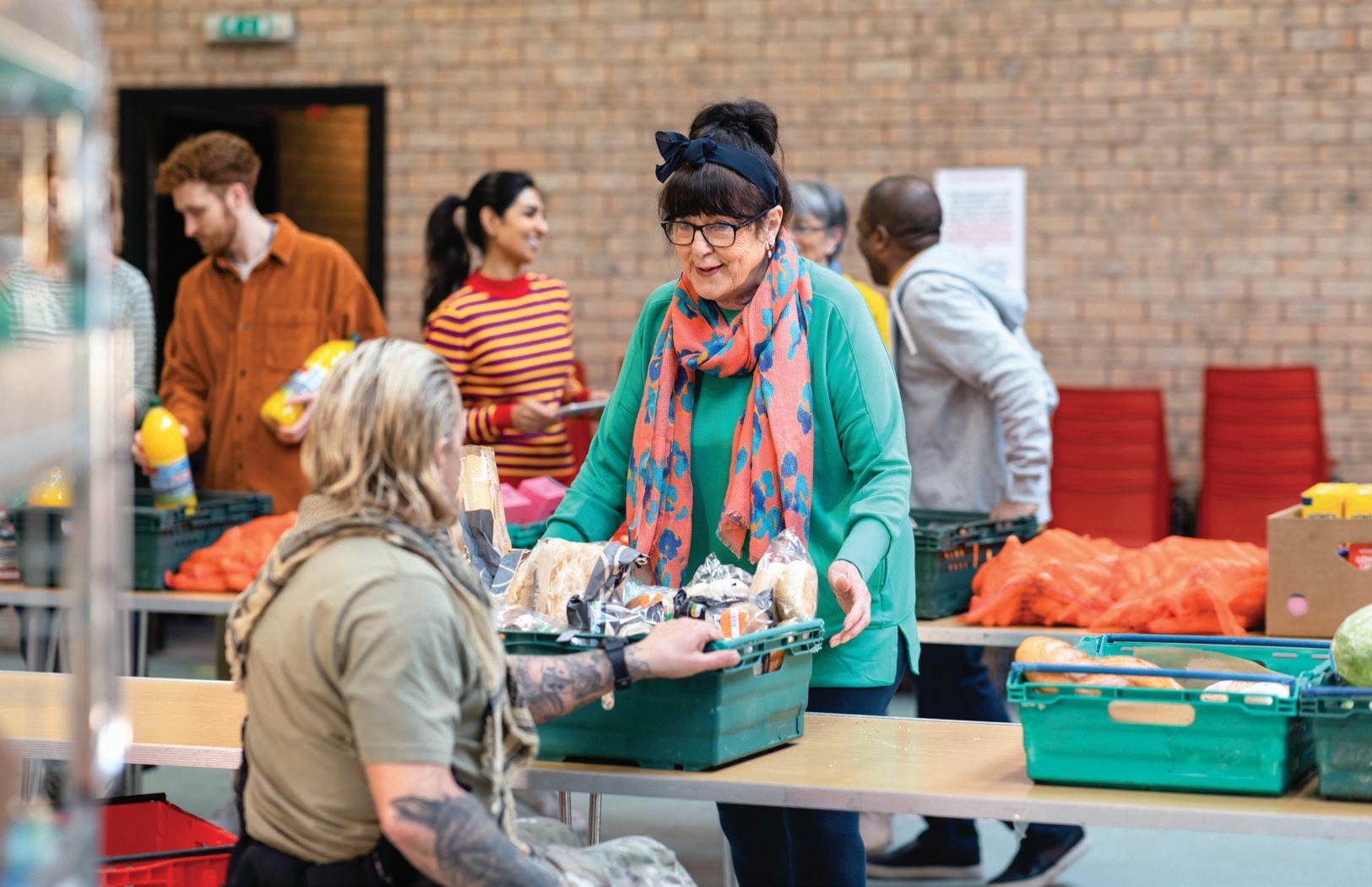
There are many different reasons people are in the category of single, especially past one’s 20s and 30s. By some accounts, almost half of Catholic adults in the United States are single. In addition to the relatively small percentage of Catholics who have taken religious vows, 5 percent are widows and widowers; 30 percent never married; and 12 to 15 percent are separated or divorced.
Single people seeking marriage or discerning a supernatural vocation (priesthood or religious life) have different needs. Many young singles today find the dating scene to be very challenging to navigate. They can find support in communities like City on a Hill, College Campus Ministries and many parishes.
carry real crosses. Loneliness, the challenge of parenting alone, dealing with custody struggles or multiple-household problems are all com mon to their experience. Anxiety, stress and depression are much higher among divorced parents than in the wider population.
just some people who are called to be single intentionally? Now, there are a small number of people who, without taking religious vows, consecrate themselves to the Church. But what we are talking about here is something else. Those who never marry don’t properly have another vocation. Marriage is a natural vocation that all men and women are called to as man and woman. Those who set aside marriage for another calling like the priesthood or religious life sacrifice the natural vocation for a super natural one. The Sacrament of Marriage (the covenant between a man and woman who are both baptized) is also a supernatural vocation built upon the natural vocation. While not precisely a vocation, singleness is nonetheless recognized by the Church as a state in life with access to specific graces of state (CCC 2004), and single people are an essential part of the parish community. In the section of the Cat echism about the Christian home, there is an important paragraph about “the great number of single persons who ... are especially close to Jesus’ heart ... who deserve special affection and active solicitude of the Church, especially of pastors.” (CCC 1658)
"While not precisely a vocation, singleness is nonetheless recognized by the Church as a state in life with access to specific graces of state, and single people are an essential part of the parish community."
Dino Durando is director of the Office of Domestic Church and Discipleship and Office of Marriage and Family Life.
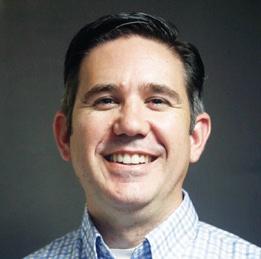
Single parents need the parish community’s support, acceptance and mercy. Unwed sin gle mothers need help and charity from the faithful. Divorced parents who remain single
Widows and widowers are part of every parish community. When their spouse dies, they go through stages of grief. Many are well cared for during the time close to the fu neral, but sometimes they are for gotten in the months and years that follow. Parish groups that help the bereaved can also facilitate making new friendships and sorting out their new situation in light of God’s providence. Friends, families and others can do this by simply being intentional about reaching out and loving them.
Finally, are those who never marry. Is sin gleness a vocation? In other words, are there
Though singleness is not a vocation, single people still have a calling. All of the baptized, from bishops to babies, have received the uni versal call to holiness. In living out this calling or vocation, the never-married person has the freedom to serve others in ways others may not. The Catechism suggests that they “live their situation in the spirit of the Beatitudes, serving God and neighbor in exemplary fashion.” In my experience, most pastors include them in the work of the parish. Perhaps they feel excluded or forgotten when plans for parish activities that focus on families don’t make room for them. Maybe we can also do a much better job of showing thanksgiving for the never-married people who do so much to build up the body of Christ among us and reach out to them and include them in our lives. Most importantly, they need to be seen, listened to and cared for.
Última Sagrada
Comunion
Uno de los días más felices en una familia es el día en el que un niño o un adulto celebra recibir la Primera Comunión - recibir personalmente por primera vez la Santa Eucaristía, el Cuerpo de Cristo.
Todavía conservo en una caja en algún sitio, el pequeño libro de oraciones, el rosario, las santas estampas, estatuillas y otros recuerdos de mi Primera Comunión junto con la fotografía de mis compañeros de la gran clase de segundo grado que compartieron ese día conmigo.

Lo que a veces se nos pasa por alto, o de lo que muchos pueden no darse cuenta, es lo que puede llamarse la Última Sagrada Comunión. Su nombre oficial es Viaticum. El nombre deriva de la palabra latina “vía (camino)” y de las “provisiones necesarias para hacer un viaje”. Mas específicamente, Viaticum se refiere a la Sagrada Comunión para los moribundos. Las Instrucciones para la Celebración del Viaticum explican: “La celebración de la Eucaristía como viaticum, el alimento para llegar a la vida eterna a través de la muerte es el sacramento apropiado para los Cristianos moribundos. Es la culminación y la corona de la vida Cristiana en esta tierra, lo que significa que los Cristianos siguen al Señor a la gloria eterna y al ban quete del reino celestial”.
Si la recepción del Viaticum es “la culminación y la corona de la vida Cristiana en esta tierra”, es obvio que nuestra Última Sagrada Comunión es tan importante como la primera, y es finalizar en esta vida lo que comenzó con los sacramentos de iniciación: Bautismo, Confirmación y Eucaristía.
Ya que las circunstancias de un cristiano moribundo varían tanto, la celebración del Viaticum puede tomar lugar en la Misa o fuera de ella. Muy a menudo, los sacerdotes celebran el Viaticum en el hogar, en el hospital o en otra institución en donde se atiende a la persona moribunda. A menudo sigue a la recepción del sacramento de la Unción de los Enfermos.
Para indicar la importancia del Viaticum, la Instrucción continúa diciendo: “Los sacerdotes y otros ministros a los que se confía el cuidado espiritual de los enfermos deberían hacer todo lo posible para asegurar que las personas que están en peligro de muerte reciban el Cuerpo y la Sangre de Cristo como viaticum”. Se asume que la persona moribunda está en completa comunión con la Iglesia y que se ha arrepentido y ha confesado todos sus pecados mortales, como es necesario para cualquier persona que recibe la Sagrada Comunión. Es por eso por lo que el Viaticum a menudo se celebra después de los ritos de la Unción y la Reconciliación celebrados por un sacerdote. Sin embargo, un diacono o un Ministro Extraordinario de la Sagrada Comunión puede administrar el más importante de los ritos de la Iglesia: El Viaticum. Obviamente, el Viaticum debe recibirse cuando la persona moribunda está consciente y es capaz de tragar.

El mes de Noviembre comienza con la Solemnidad de Todos Los Santos, y sigue inmediatamente la Conmemoración de Todas las Almas, es un mes en el que tomamos un cuidado especial para recordar a los fieles que han partido antes que nosotros. También se nos recuerda que un día todos nosotros nos encontraremos en la “hora de nuestra muerte”, algo que anticipamos con cada Ave María. Acompañados de la intercesión de nuestra Madre Bendita, seamos conscientes del precioso don del Viaticum que la Iglesia ofrece a sus hijos en esa “hora” — La Sagrada Eucaristía y nuestra Última Sagrada Comunión.
Del Obispo
El obispo James V. Johnston, Jr. es el séptimo obispo de la Diócesis de Kansas City-St. Joseph

“Jesucristo es el alimento para nuestro viaje: Él nos invita a la mesa celestial”
— Del Rito de Celebración del Viaticum
TOP 5TOP 5
Hispanic holiday traditions you need to know about
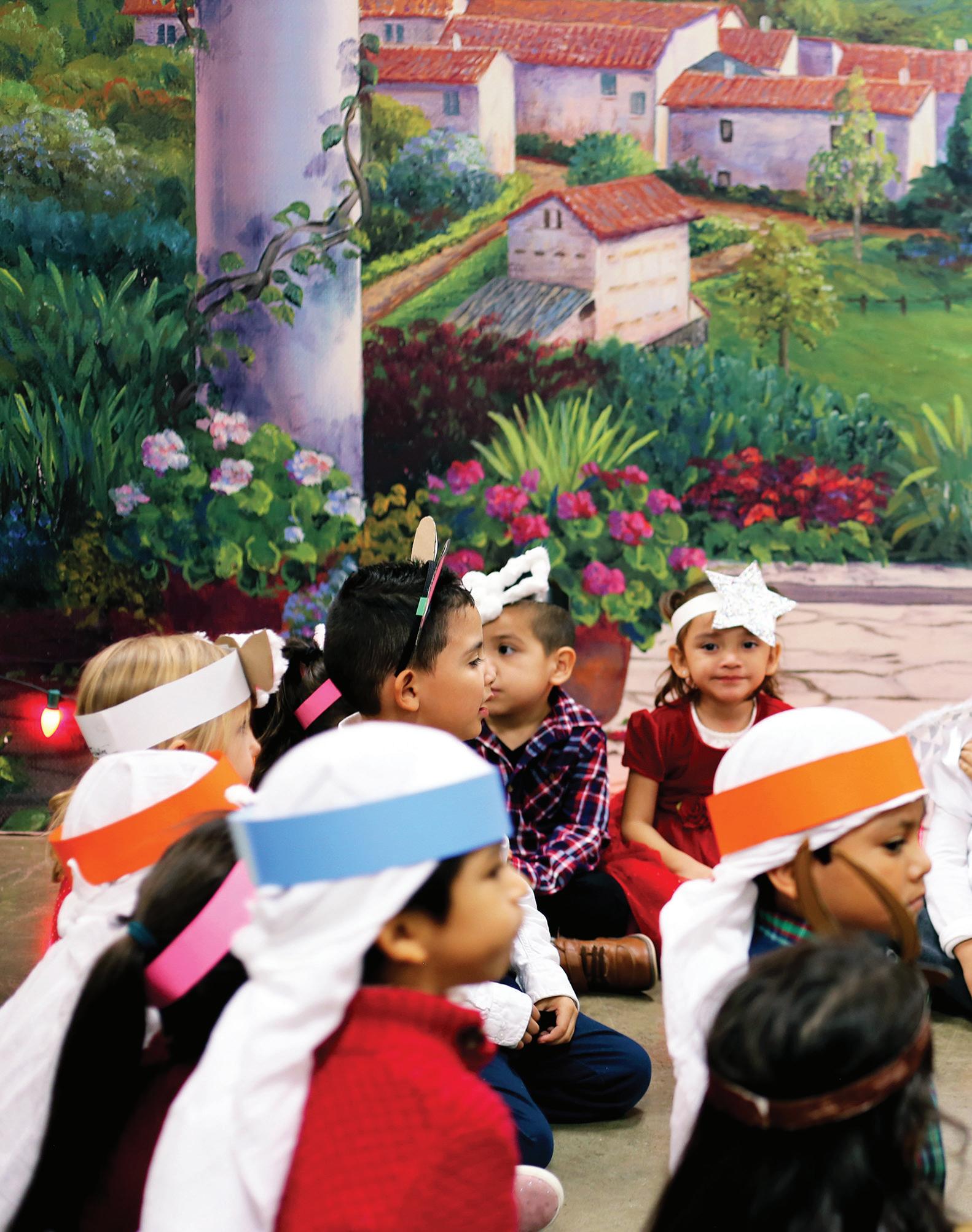 By Leyden Revolo-Krull
By Leyden Revolo-Krull
Most people are familiar with the Day of the Dead holiday celebrated on Nov. 2. But did you know Latinos have all kinds of wonderful traditions for the holiday season? Here are the top five Hispanic/Latino holiday traditions you need to know!
Las Posadas — Mexico
One of the oldest traditions, Las Posadas has been part of Mexico’s Christmas since the 15th century. The event consists of a nine-day pilgrimage and reenactment of Mary and Joseph’s journey to Bethlehem. During this procession, people will knock on neighbors’ doors asking to be let inside and given shelter for the night. The pilgrimage serves as a spiritual exercise drawing us closer to Jesus’s birth through the virtues of humility, charity and confidence in God’s providence.
El Nacimiento
Unlike a typical Nativity scene, El Nacimiento may con tain special items that remind us of our loved ones such as favorite foods, flowers or small items that commem orate them.
Niño Jesus brings presents
While many credit Santa Claus with bringing gifts, in Latin America this joy is reserved for el Niño Jesus. Christmas is meant to celebrate the incarnation of the newborn King, who gives his life for his people. Therefore, Latin American children are invited to remember that all good gifts come from God.
Dia de las Velitas — Colombia
To initiate the Christmas season, Colombians light candles and paper lanterns in public places in honor of the Virgin Mary. This Dec. 7 tradition is meant to commemorate the Immaculate Conception, and it kicks off the holiday.

Our Lady of Guadalupe
Dec. 12 marks the Virginencita’s appearance to San Juan Diego in 1531 Mexico. If you cannot make it to the celebrations at the Basilica of Our Lady of Guadalupe in Mexico City, then be sure to visit Our Lady of Guadalupe Shrine in downtown Kansas City to commemorate this special day. In 2022, Bishop Johnston is scheduled to celebrate Mass at 6 a.m., followed by Mañanitas.
Try to find ways to incorporate some of these traditions into your own. Who knows? You may start a new way to celebrate the holidays!
principales ¡LAS 5
tradiciones navideñas hispanas que debe conocer!
L a mayoría de la gente conoce la festividad del día de muertos que se celebra el 2 de noviembre. Pero, ¿sabías que los latinos tienen todo tipo de tradiciones maravillosas para la temporada navideña? ¡Aquí están las 5 tradiciones navideñas hispanas/latinas que necesita saber!
Las Posadas — México

Una de las tradiciones más antiguas forma parte de la Navidad mexicana desde el siglo XV. Esta celebración de nueve días es una peregrinación recreando el viaje de María y José a Belén. Durante esta procesión, la gente llama a las puertas de los vecinos buscando cobijo para pasar la noche. Las posadas sirven como ejercicios espirituales a medida que nos acercamos al nacimiento de Jesús a través de las virtudes de la humildad, la caridad y la confianza en la providencia de Dios.
El Nacimiento
Otra hermosa tradición es el nacimiento. A diferencia de un belén típico, el nacimiento puede contener elementos especiales que representan a nuestros seres queridos. Por ejemplo, comidas favoritas, flores o pequeños artículos que los conmemoren.
Niño Jesús Trae Regalos
Si bien muchos le dan crédito a Santa Claus por traer regalos, en América Latina es el Niño Jesús. La Navidad es para celebrar la encarnación del Rey recién nacido que da la vida por su pueblo. Por eso, los niños latinoamericanos reconocen que todos los buenos regalos vienen de Dios.
Día de las Velitas — Colombia
Para iniciar la temporada navideña los colombianos encienden velas y farolillos de papel en honor de la Virgen María. ¡Esta tradición del 7 de diciembre está destinada a conmemorar la Inmaculada Concepción y da comienzo a la festividad!
Nuestra Señora de Guadalupe
Otro día importante que querrán celebrar es la fiesta de Nuestra Señora de Guadalupe. El 12 de diciembre marca la aparición de la Virginencita a San Juan Diego en 1531 México. Si no puede asistir a las celebraciones en la Basílica de Nuestra Señora de Guadalupe en la Ciudad de México, asegúrese de visitar el Santuario de Nuestra Señora de Guadalupe en el centro de Kansas City para conmemorar este día especial. En 2022, el Obispo Johnston está programado para celebrar la misa a las 6 a.m., seguido por las mañanitas.
¡Trate de encontrar formas de incorporar algunas de estas tradiciones en las suyas! ¿Quién sabe? ¡Puede comenzar una nueva forma de celebrar las fiestas!

TRUST Building
By Ashlie HandAs the Director of the Office of Child and Youth Protection (OCYP), Carrie Cooper has spent the last 11 years overseeing the diocese’s response and prevention efforts related to child sexual abuse and suspicious sexual behavior, carefully and intentionally rebuilding the trust lost due to abuse of minors in our diocese.

Carrie was hired to expand child protection efforts through the OCYP following a scandal in our diocese that resulted in great harm to our local Church community. Subsequently, a diocesan priest was sentenced to 50 years in federal prison and a bishop was charged with failure to report child sexual abuse.
Q What drew you to your role with the OCYP?
As a lifelong member of this diocese, I was drawn to this role to offer my background in leadership and compliance to make a difference. My three children were very young and starting their Catholic school education. I felt called to help my diocese to create a solid program to ensure they and all children were safe.
Q What is a typical day like for you in your role?
There is no typical day for me. I make it a priority each week to meet individually with every member of my service area to review their goals and support their efforts. We meet and collaborate weekly as a team. I meet daily with internal and external partners, respond to policy inquiries and issues and work on projects to improve the structure and policies that guide our work going forward.
Q What is the most important characteristic in earning and building trust with those you work with in the diocese?
The most important characteristics in earning and building trust are accepting responsibility for breaking that trust and being accountable. This includes being fully present with people, listening, responding with care, meeting them where they are and opening paths for restoration.
Q How do you interact with the parishes and schools in our diocese?
The OCYP has several interaction points with parishes and schools on a daily basis. Communication, training and compliance are vital to the success of our core value of protecting children from abuse.
Read more about Carrie and the work of OCYP at catholickey.org
Q What is the most rewarding aspect of the work you do in our diocese?
The most rewarding aspect of the work I do is knowing I’ve implemented policy and procedure, training and awareness to make our schools and parishes some of the safest places for children to be. I believe it is the responsibility of adults to protect children.
RESTORATIVE JUSTICE AND HEALING
THE RELATIONSHIP OF PRAYER

Marc Cardaronella is the director of the Office of Catechesis and Faith Formation.

The Catechism of the Catholic Church (CCC) is more than just a compilation of the essential truths of Catholic teaching. It also presents a methodology for understanding these truths and making them a part of our lives.
There are four parts to the Catechism: the Creed, the Sac ramental Liturgy, the Moral Life, and Prayer. They are known as The Four Pillars. The Catechism of the Council of Trent, published in 1566, was divided this way, as well. The Four Pillars are ancient. From earliest times, this is how the Cath olic Faith was presented. It’s how life was structured in the earliest Christian community that grew in Jerusalem after the Resurrection. We see this in Acts 2:42, “They devoted themselves to the apostles’ teaching and fellowship, to the breaking of bread and the prayers.”
I write this to prepare you for understanding the first para graph of Part Four, “Christian Prayer.” The Catechism itself helps us grasp the organic connection between its “pillars” in the introductory paragraphs of each part. Since it's the last part, the introduction on prayer perfectly sums up the whole:
‘Great is the mystery of the faith!’ The Church professes this mystery in the Apostles’ Creed (Part One) and cel ebrates it in the sacramental liturgy (Part Two), so that the life of the faithful may be conformed to Christ in the Holy Spirit to the glory of God the Father (Part Three). This mystery, then, requires that the faithful believe in it, that they celebrate it, and that they live from it in a vital and personal relationship with the living and true God. This relationship is prayer. (CCC 2558)
You see, we can only understand the true nature of prayer within the context of the whole Christian life. The Creed reveals God’s work of creation, redemption and sanctification. Liturgy and sacraments are how the grace of redemption is given to us. These first two parts are about what God does for us. The second two are about what we do in response. The Catechism presents morality as the demands of facili tating a relationship with God. It’s how we live in response to God’s gifts of revealed truth and grace. Prayer is how you stay in relationship with God. Prayer is, in a sense, the relationship itself.
Prayer is more than asking God for what you need. Prayer is an encounter with God, a merging of thirsts. God thirsts for us and draws us so that we may thirst for him. (cf. CCC 2560) God reveals the mystery of his life and communicates it through the sacramental liturgy. Changed by grace, we are transformed into children of God, “partakers in the divine nature” (CCC 460). The Holy Spirit helps us realize this great dignity and calls us to live in accordance with it. But it's only possible through the grace of the sacraments and through prayer. Prayer is a response of the heart in gratitude for this life in the Spirit we've been given.
The next time you pray, do ask for what you need. But also seek to better know and grow closer to the God who longs to be closer to you.
and obituaries
Years of devotion and service to God and to the Church are not an easy undertaking. It is worthy of congratulations, celebration and, especially, thanksgiving to God. Following is a list of priests and religious in the Diocese of Kansas City-St. Joseph celebrating special anniversaries of ordination or profession in 2020 and 2021 - the diocese recognizes and celebrates this happy occasion. Be sure to include these priests and religious in your prayers and congratulate them!
Priests celebrating jubilees in 2022
• 70 years: Father Norbert Schappler, OSB
• 60 years: Father Edmund Boyce, OSB; Father Ernie Gauthier; Father Kevin Murphy, OSB; Father Paul Sanders, CPPS; Father Roger Schmit, OSB
• 55 years: Father Terry Bruce; Father Jerry Waris
• 50 years: Father Jim Healy
• 45 years: Father Mike Clary
• 40 years: Father Phil Egan; Father Tom Hermes; Father Dave Holloway
• 25 years: Father Dan Reardon
Religious celebrating jubilees in 2022
• 75 years: Sister Kathleen Gorman, OSB
• 70 years: Sister Josephine Boyles, OSF; Sister Louise de l’Assomption, lsp; Sister Mary Laurentia Doyle, OSB; Sister Mary Bede Luetkemeyer, OSB; Sister Mary Benita Luetkemeyer, OSB; Sister Mary Jane Romero, OSB
• 60 Years: Sister Mary Lucy Lang, OSF; Sister Gabrielle Smits, CSJ; Sister Francis Voivedich, CSJ
• 25 years: Sister Colleen Maura McGrane, OSB
In Memoriam
• Father Donald E. Sturm: April 19, 1932-September 26, 2021
• Deacon Steven Edward Welsh: July 26, 1943-October 3, 2021
• Deacon Alfred “Freddy” Santellan, SOLT: June 10, 1940-October 20, 2021
• Father Charles Michael Coleman: July 8, 1941-January 4, 2022
• Father Michael Jerome Gillgannon: September 23, 1933-June 19, 2022
• Brother Marvin Hamann, C.Ss.R.: January 9, 1930-June 24, 2022
• Sister Mary Pascaline Coff, OSB: January 20, 1927-December 16, 2021
• Sister Ann Louis Strizek, CSJ: April 19, 1936-January 12, 2022
•
Sister Michaela Zahner, CSJ: December 7, 1941-January 31, 2022
• Sister Marie Sullivan, OP: September 17, 1931-February 9, 2022
If we have missed a diocesan priest or a religious order priest or sister who spent time in the Diocese of Kansas City-St. Joseph either cele brating a jubilee in 2022 or who passed away after September 2021, please let us know so we may add them to this 2022 list on CatholicKey.org

• Sister Donna Ryan, RSM: October 18, 1941-July 31, 2022
• Sister Claudette Schiratti, RSM: March 13, 1939-August 21, 2022
• Sister Mary Jane Romero, OSB: August 13, 1932-August 27, 2022
“I keep my eyes always on the Lord. With him at my right hand, I will not be shaken.” - Ps. 16:8
“My heart is glad and my tongue rejoices; my body also will rest secure…” - Ps. 16:9
Eucharistic Revival
AN ADORATION ROAD MAP
How often do you visit friends or family?

It’s certainly easier to strengthen these relationships when you can see them often.
St. Patrick, Forest City: Adoration every second Sunday at 7:15 a.m.
Newman Center at Northwest Missouri State University, Maryville: Adoration available for students after the 5 p.m. Sunday Mass through 8 p.m. Thursday.
St. Joseph, Trenton: Holy halfhour 6 p.m. Tuesdays until 6:30 pm Mass.
Similarly, it can be easier to enter into a deeper relationship with our Eucharistic Lord when his house is open for you to visit him. Here are just a few times and locations for Eucharistic Adoration in our diocese:
Cathedral of St. Joseph, St. Joseph: Adoration available Monday through Friday from 8 a.m.-3 p.m., except when school is closed. Contact the parish office to verify it is open.
Church of the Good Shepherd, Smithville: Adoration is held on the first and third Sunday of the month, following 10:30 a.m. Mass until midnight.
find many more locations at kcsjcatholic.org/ involve/eucharisticadoration
St. George, Odessa: Holy hour on Tuesdays starting at 5 p.m.
Attending adoration at your parish?
Snap a quick pic and tag @DioceseKCSJ on social media
We want to share local adoration times and your photo with everyone! Be sure to use hashtags #EucharisticRevival and #DioceseKCSJ
Christ the King, Kansas City: 24-hour adoration in the St. Peter Julian Eymard Chapel. Doors open daily 6 a.m.-5 p.m.; contact office for after-hours access.
St. Bridget, Pleasant Hill: Adoration every Thursday from 10 a.m.-8 p.m., and every fifth Friday from 5 p.m. to 4:45 p.m. Saturday.
St. Patrick, Holden: Adoration with Confessions 11-11:50 a.m. every Friday, concluding with Benediction before noon Mass.
